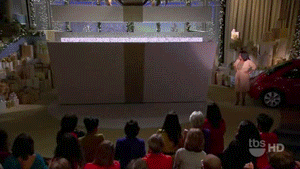
Još jedno pitanje na koje moramo odgovoriti?
A D Jameson
Animated Gifs as Cinema
I was planning to put up the next installment in my experimental fiction series today (part 1, part 2), but school has interfered. (I’m writing a paper on Dickens’s use of the narrative present in Great Expectations, plus grading 40-something research papers written in response to Hanna Rosin’s The End of Men: And the Rise of Women.)
In the off chance that you’d like to read something new by me, I recently published an article at the film site Press Play, “Are Animated Gifs a Type of Cinema?” Since then, Landon Palmer has responded with an article at Film School Rejects(“Animated Gifs are Cinematic, But They’re Much More Than Cinema“), as has Wm. Ferguson at the 6th Floor, the New York Times Magazine‘s blog (“On the Aesthetics of the Animated GIF“). I’m planning a follow-up post as well as an interview with Eric Fleischauer and Jason Lazarus, the directors of the gif anthology film twohundredfiftysixcolors, whose premiere I managed to catch a few weeks back. And the Press Play article is itself a follow-up to two articles I posted at Big Other in early 2011: “How Many Cinemas Are There?” and “Why Do You Need So Many Cinemas?”
I’m only just beginning my studies on the gif, so I appreciate any and all feedback.
Are Animated Gifs a Type of Cinema?
BY
Well, are they? I’m inclined to argue that they are. Indeed, I’ve already done so, in two posts I wrote a couple years ago elsewhere: “How Many Cinemas Are There?” and “Why Do You Need So Many Cinemas?” There, inspired by comics scholar Scott McCloud’s ultra-lean definition of comics (“sequential art”), I proposed that cinema be thought of simply as “moving images.” Making that mental leap expands the cinema to include not just feature-length films and shorts, but also television shows, music videos, YouTube videos, video games, flash animations—and animated gifs. (I even argued that cinema should include certain “non-electronic” forms, such as flip books, magic lanterns, and shadow puppetry.) I won’t rehash that whole argument here; instead, I want to look solely at animated gifs. Are they cinema?
Admittedly, I don’t know anyone who is arguing that they aren’t. But I also don’t know anyone (with one exception) who’s arguing that they are. Indeed, no one seems overly concerned with the matter. But I think it makes sense to examine the relationship between animated gifs and other forms of cinema, as well as to try describing the format’s unique cinematic aesthetic. Here are a dozen reasons why.
1. They’re often taken from cinema, as people extract smaller moments from longer films. Here’s a famous example:

This gif basically consists of two shots, roughly two-and-a-half seconds, taken from Star Trek: First Contact (1996).
2. If that’s all animated gifs were, then they would be truly derivative works—very short video clips (with a reduced color palette). But animated gifs can be used to create new works, by combining moments from different films. For instance, you might often see those two shots in the Picard gif followed by a third:

Or:
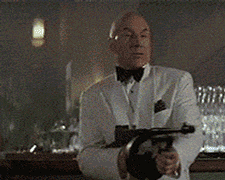
These examples edge us closer to the world of video art, or earlier experimental films that derived their effects from juxtaposing footage from different films. These Picard gifs remind me of the moment in Bruce Conner’s classic 1958 film A MOVIE where the submarine captain looks through the periscope (4:17–4:19):


. . . to spy a pin-up model reclining on a bed (4:19–4:24):
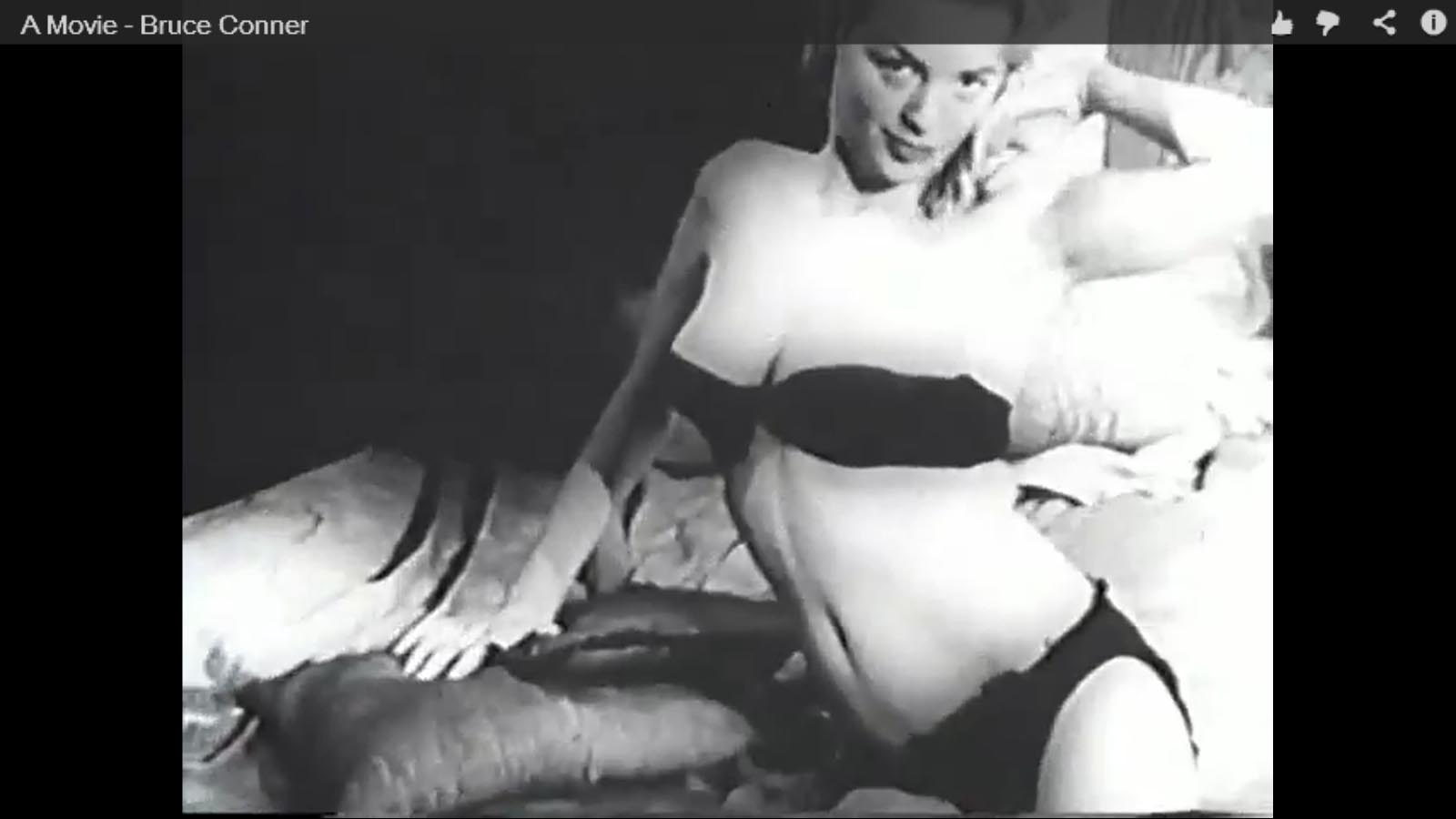
(You can watch A MOVIE here, which is where I took these screen captures from.)
Both A MOVIE and these animated gifs employ some common cinematic principles. The cuts create an eyeline match, which make it appear as though the characters are looking at one another, and obey the 180-degree rule(meaning that if you draw a straight line between their eyes, our perspective stays to one side of it). (Incidentally, the juxtaposition in A MOVIE works better than the above images might suggest, because right before the cut, the submarine captain is shown twisting the periscope from left to right.)
I’ve seen a different version of the Picard vs. Chunk gif:

. . . and I’d argue that it doesn’t work as well as the first one we considered:

. . . which better matches the eyelines, and obeys the 180-degree rule.
This suggests that animated gifs possess an aesthetic similar to cinema’s.
3. Besides combining shots taken from different films, animated gifs can also juxtapose different types of cinema, such as live-action and animation:


. . . or even live action and video games:

This second example suggests that we might also consider video games a type of cinema—though we need not get into that now.
4. Gifs can also composite different types of footage within the same image. Here’s a particularly notorious one that I’ve written about at the lit blog HTMLGIANT:
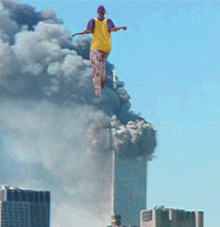
Here we have two different pieces of television footage combined in a single image. And leaving aside the (deliberately offensive) content, we can see another potential for the form. Composite editing is by no means unique to gifs; Georges Méliès discovered double exposures soon after filmmaking was invented—see for instance Un homme de têtes, aka The Four Troublesome Heads (1898), viewable here. But gifs, being a natively digital format, might more easily encourage such recombination. (Méliès is their milieu?)
The Picard vs. Chunk gif above, in fact, contains composite editing. Here’s a screenshot taken from the scene in The Goonies (1985) where Chunk originally performed the Truffle Shuffle:
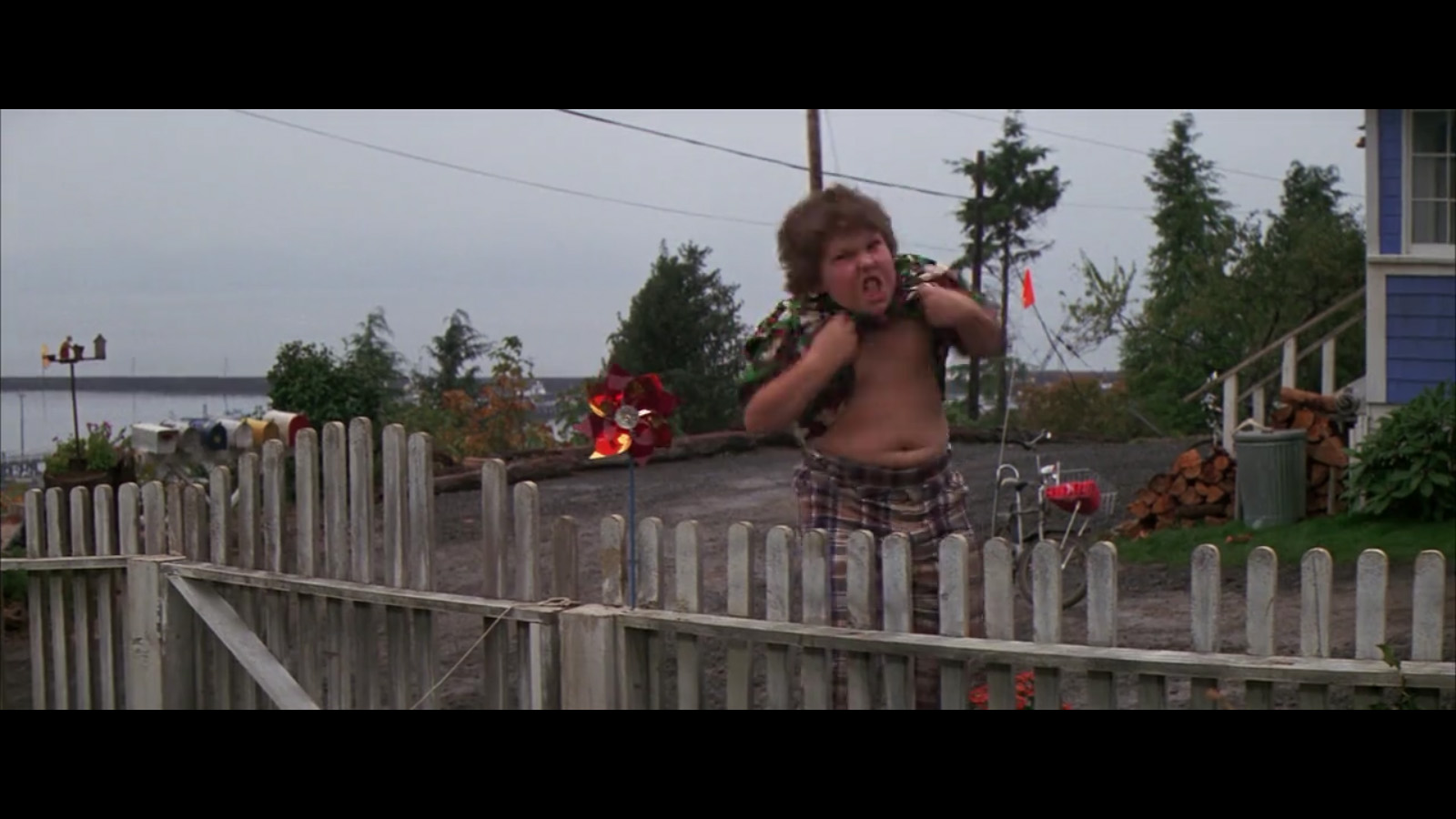
Whoever made the gif removed Chunk from that setting, and placed him front of another. I’ve spent more time than I care to admit scrutinizing scenes in The Goonies and First Contact, and I still can’t tell where that second background hails from. Here’s a capture of the shot in First Contact that follows the close-up of Picard firing:
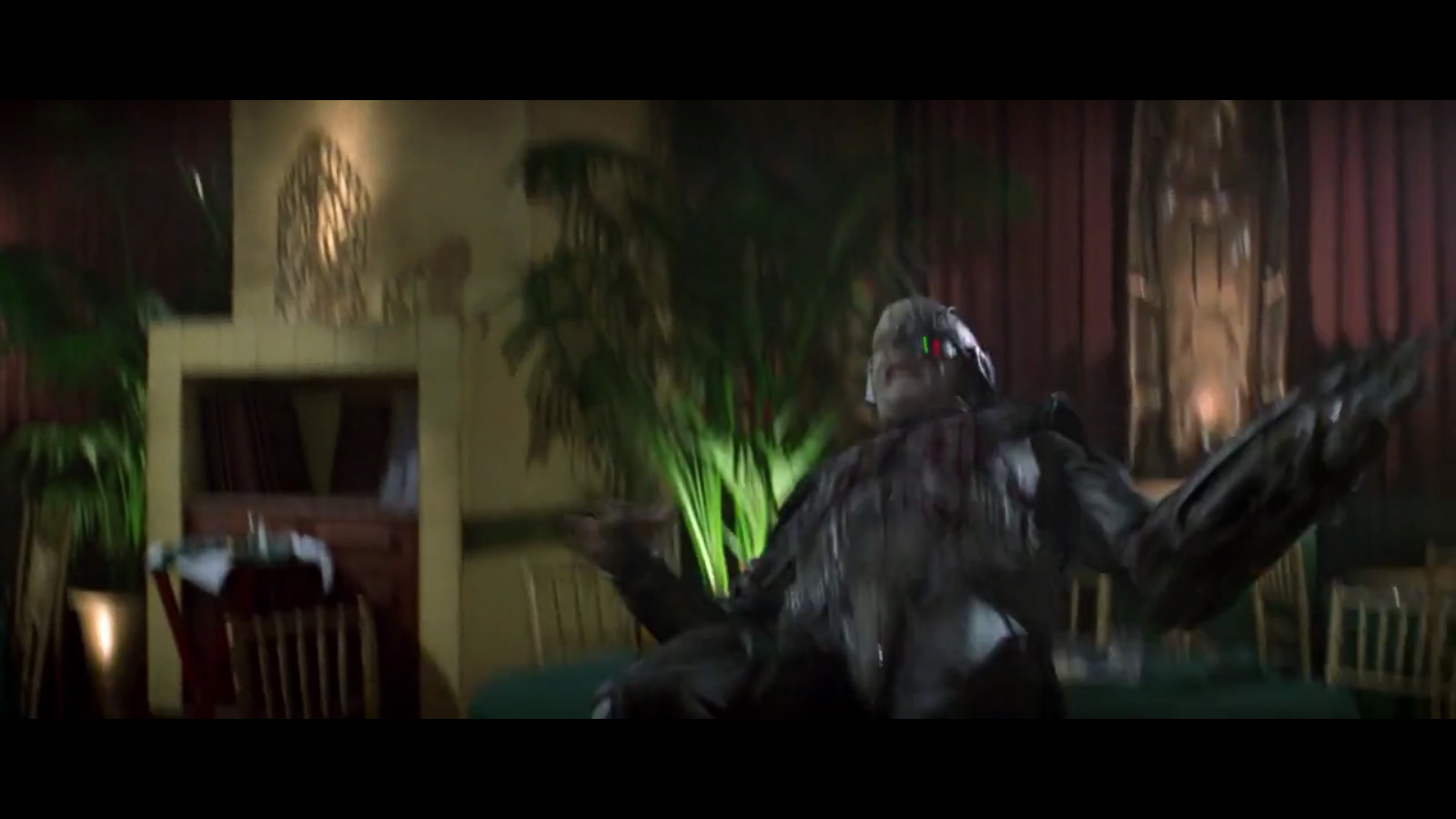
(Of course the footage behind Chunk might not even have come from First Contact, but some third film.)
Still more work has been done on this gif. The bullet tracer effects have been added. And we can now see why Chunk is facing right in that one gif—that’s the way he was facing in the original shot. This suggests that the right-facing gif came first, after which someone changed it by turning Chunk to face in the opposite direction. (Since anyone who can view a gif can, in theory, also edit it, gifs are arguably a wholly populist form of cinema.)
Look again at the first Picard gif, at the very top of this article, and compare it to the others. You’ll see that its first shot is different: it’s been extended by rolling the footage backward, then forward. (In First Contact, Picard moves only forward in that shot.) If we wanted to, we could now take that extended footage of Picard and paste it into the left-facing Chunk gif.
5. Another way that gifs differ from their sources is that they often reframe shots—which is part of why it’s difficult to determine where Chunk is standing. The shot has been whittled down to focus on just him. The shots of Picard firing have also been narrowed; compare the gif with these screenshots:

And:
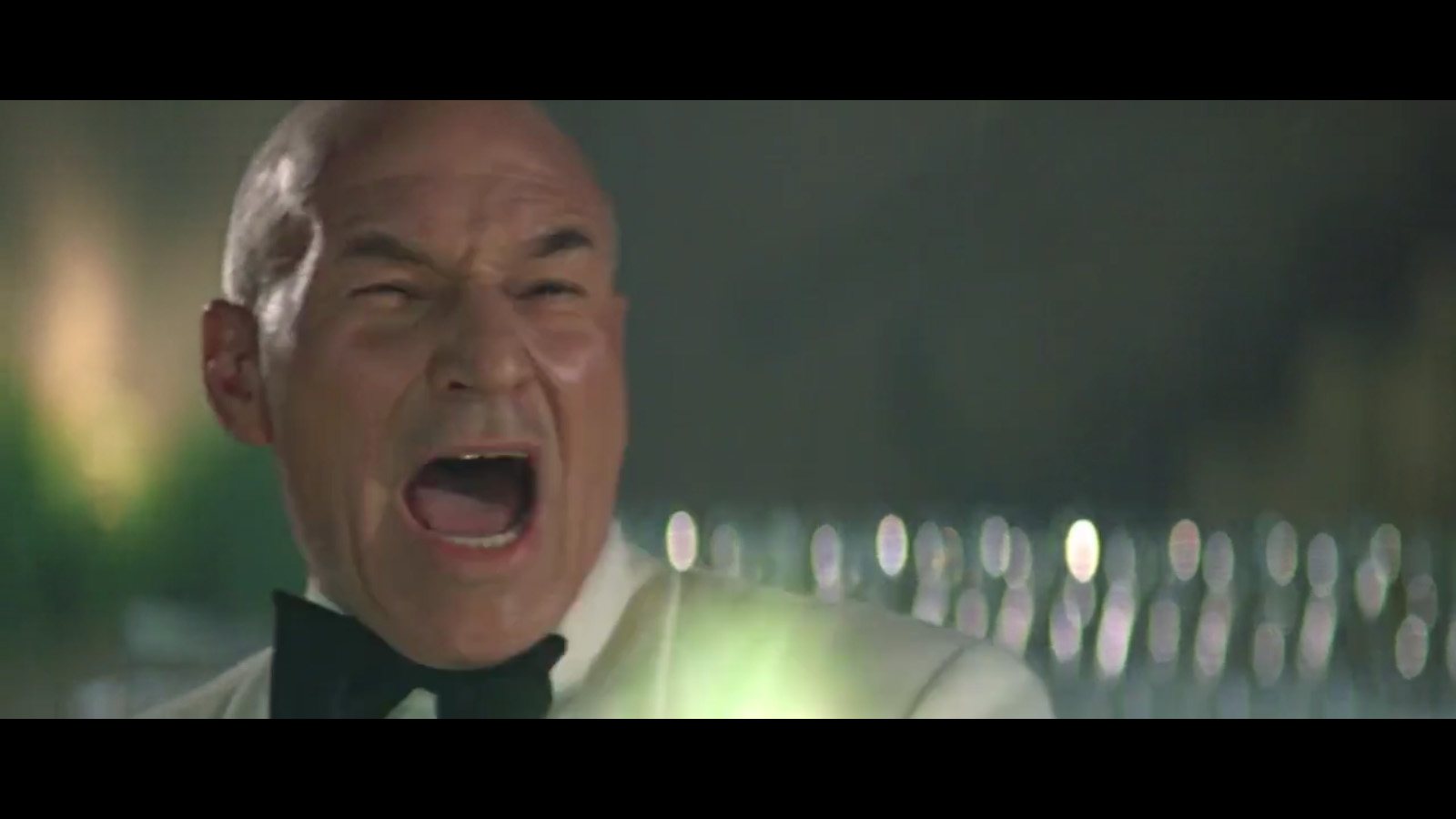
Because animated gifs are lower resolution than film—not to mention often postage-stamp sized—they benefit from focusing the viewer’s attention on a single central image. Picard + Tommy gun = all that’s really needed.
This might suggest that gifs have a different aesthetic than filmmaking, but I’d argue it’s more a matter of desired effect. In First Contact, the focus of the shots is certainly Picard’s attack on his Borg foes, but the scene occurs within a richer environment. The scene takes place roughly an hour into a film in which most of the action is set aboard the Enterprise, which is under siege from the Borg. Picard lures two of those aliens onto the ship’s holodeck, trapping them in a simulation of a hard-boiled detective novel. The movie needs to portray a convincing-enough environment in order to keep its audience immersed in the somewhat outlandish fantasy. Along the same lines, when watching The Goonies, it’s important that viewers understand that Chunk does the Truffle Shuffle outside a house in Astoria, Oregon.
But the animated gifs we’ve been looking at aren’t concerned with that kind of world-building, being much more concentrated on a narrower and more immediate effect. Their makers probably wanted us to recognize the source material (they took footage from very well-known films), but the focus is relocated to the comic juxtapositions. Cutting out most of the background helps the viewer to get the joke. Viewed in this light, I’m surprised the Picard/Chunk gif’s original author bothered editing Chunk into a matching background. The other gifs work fine without going to that degree of trouble. (Indeed, you might argue that the shift in setting heightens the joke.
6. Here we have a hint of a way in which gifs possess a different aesthetic than feature-length movies, or at least operate differently given similar concerns. Someone makes a gif where Picard seems to be shooting Chunk. Then someone makes one where Picard seems to be shooting Doc Brown. What’s next? Well, someone could make yet another gif where Picard seems to be shooting another popular 1980s movie character—but aren’t returns already starting to diminish? To keep the joke alive, we need something unexpected. So someone makes a gif where Picard seems to be shooting at a Tiny Tunes character. Or at the ducks in Duck Hunt.
I haven’t seen it myself, but I imagine someone’s made a gif where Picard appears to be firing at some documentary footage—video taken from a real-life shooting. Or even footage of the Twin Towers collapsing.
Makers of full-length movies definitely have to work to one-up each other. But that cycle might be accelerated in the world of gifs, where the impact is much more immediate.
7. Along these lines, we can see that animated gifs are often greatly concerned with emphasis, by:
- Isolating a particular moment;
- Focusing on a single element within the shot;
- Creating a startling juxtaposition (through either composite or montage editing).
Gifs also tend to emphasize movement. When I told a friend that I was writing this article, she argued that “animated gif” was redundant, because the only gifs people care about are animated ones. I nonetheless decided to keep “animated” because it is possible to make static gifs, and I don’t want to argue that static gifs are cinema. (Cinema ismoving images.)
But my friend was right. Who wants to see a static gif? In fact, it seems to me that the best gifs often involve a flurryof motion, or remain static until a crucial moment, which usually comes at the end of the loop:

And:
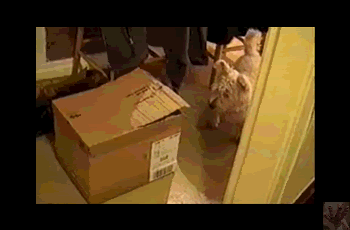
Gifs select footage and emphasize it. They focus attention.
8. That’s not all that animated gifs can do, however. Some are longer, and as such closely resemble short films. For instance, here’s an animation that traces the development of the NYC subway system:
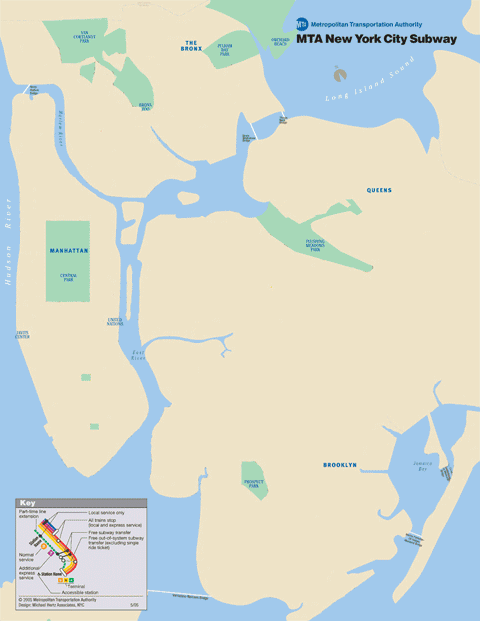
Once again, I’m reminded of an existing film: Ray and Charles Eames short movie Atlas (1976), which presents “A Sketch of the Rise and Fall of the Roman Empire.” (You can watch it here.)
To be sure, these are different works. The NYC subway gif lacks sound (music, voice-over narration). But the presence of sound isn’t essential for cinema. (The five-minute-long Eames film presents its animation twice, and the second time it drops the narration.)
Animated gifs arguably benefit from their silence, which becomes another way to focus attention on visuals themselves.
9. We’re gradually constructing a case that the value of gifs stems from their poverty of resources—from the limitations inherent in the format. Along these lines, gifs possess unique cinematic value due to their brevity.
The earliest films, made by the Lumiere Bros. and Thomas Edison, usually ran at least thirty seconds long. Since then, the movies have mostly gotten longer. Now animated gifs are exploring another side of cinema—movies that run under thirty seconds, and often under five. If they are cinema, then they rank among the shortest movies ever made.
10. Gifs also explore the opposite end of the spectrum: infinity.
While some gifs present what amounts to a scene, others employ the form’s looping quality to create an endless ongoing video. Here’s a famous example, taken from a mid-90s internet meme:
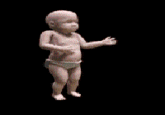
The gif version of this video forgoes the original meme’s accompanying music (“Ooogachaka, ooga, ooga . . . “). But its dancing baby will dance forever
11. All of this suggests that animated gifs have their own cinematic purpose. Hence their effectiveness as erotic artworks: gif makers can distill crucial moments from larger pornographic films, enabling people to watch them on repeat.
In her recent Salon article, “Better Than Actual Porn!“, Tracy Clark-Flory ponders whether pornographic animated gifs are more like short videos or longer photographs. I’d argue that they exist on a spectrum between those two forms, capable of moving more toward one side or the other. The above Picard gifs are more like short videos. But the NYC subway gif and the dancing baby gif are arguably more like enhanced photos. (The subway gif is like an enhanced diagram.)
The important point, however, is that animated gifs are novel—similar to, but not exactly the same as movies as we’ve known them. They are, in other words, a new form of cinema. (Clark-Flory comes to something of the same conclusion when she writes that gifs are becoming an alternative form of pornography, but aren’t replacing videos or photographs.)
12. Cinematic viewing habits are changing: more and more movies are being watched online. Folks still go to the cinema, of course, and they still rent DVDs. But they also watch movies on their cell phones and laptops, which is where animated gifs thrive. In this way they might be modern-day versions of the Kinetoscope or Mutoscope: a private form of cinema limited to a particular type of device (although it probably won’t be long before gifs start popping up on electronic billboards). This is yet another way in which gifs resemble the movies as we known them, and yet diverge, providing a new incarnation of the familiar.
In summary, animated gifs partake in the broader aesthetic of cinema, even as they use their formal limitations to craft effects that we experience in non-traditional film environments. I have no doubt that they will eventually come to be regarded a unique form of movie-making, just as gallery-bound video art eventually was, and that certain gifs will be singled out for their aesthetic and historical import. Already I’d claim that there’s value in preserving and teaching some of them, such as Picard vs. Chunk and the Fresh Prince/9-11 one . . .
And it probably also won’t be long before feature-length movies start borrowing effects from gifs, the same way that the recent spate of “found footage” films—Paranormal Activity (2007), [Rec] (2007), Cloverfield (2008), Chronicle(2012)—have drawn key aspects of their aesthetic from YouTube. And while writing this I encountered the only other argument I know of that animated gifs are a type of cinema: Twohundredfiftysixcolors, Eric Fleischauer and Jason Lazarus’s feature-length compilation of 3000 gifs, scheduled to screen on 18 April at Chicago’s Gene Siskel Film Center. (I’m planning to attend.)
Your thoughts on all of this?
http://blogs.indiewire.com/pressplay/are-animated-gifs-a-type-of-cinema

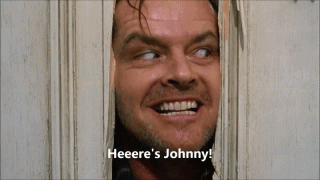



Over the past year I’ve stayed mostly silent when it comes to critical writing. Some of this has been due to lack of time. Some of it to a hesitancy to speak critically of those who are or may be peers. Lastly, some of the most vocal folks are exhausting in their epic word counts! But I’ve been thinking a lot, and have decided that a) I want to write more and b.) I won’t stand by while those with more critically rigorous but divergent views and practices sculpt the terms by which we think of Art, Net Art, and especially the burgeoning field of Social Media Art.
The distinction between Net Art and Social Media Art is important, and will be outlined in a future post. Further, I do not identify as a Net Artist (or a Social Media Artist, for that matter). However they often occupy the same sentence in the conversation. My interest in this series is specific to my practice, but my practice is also driven by what I want the future to look like for art appreciators of all varieties.
By setting out to describe this future, I want to first pause to express my concerns with the present. Specifically, with animated GIF art. On the whole, it is depressingly vapid! Worse, its vapidity has been fetishized by those seeking to define and contextualize this next wave of Internet artists. Over the years I’ve seen thousands of animated gifs. I’ve spent countless minutes waiting for them to cycle through their frames so they can be experienced “appropriately.”
One recent example that comes to mind is the Unknown Pleasures meets Matrix-green animated gif that Paddy Johnson highlighted in her Year Of The Animated Gif post. Beyond occasionally witty one-liners, most of these images do nothing to push how we think. Rather they tend to engage in a sort of post-hipster language. They’re stylized, abstract, and, in my opinion, just plain weak images. Of the non-abstract variety exists an Internet kitsch aesthetic which tend to be ironic, cynical and intentionally crude. Both of these varieties remind me of an article I read in New York Magazine a few months back that described Hipsters as smart consumers but whose cultural contributions were few. Or sloppy, lazy, etc. I would put 95% of animated gifs in this category. Granted the culture is arguable larger/more important than the “product,” however, the product usually leaves me with much to be desired.
Needless to say this is not the type of work I want to make. While some of it is certainly entertaining, I am attempting to make work that is both accessible, challenging, subversive, and most importantly authentic.
I believe that the medium must serve the work, and that the work must havesomething to say, regardless of what medium that is (gif, oil paint, collage, etc). Aesthetics alone, however well stylized or unique, are never enough to carry a great work. A work that transcends its form. While I can’t speak to anyone else’s intentions I can say that I don’t want to spend my time framing images that offer limited cultural capital. I by no means claim that my work always transcends, rather it is an ideal that I am continually striving towards.
To be continued!



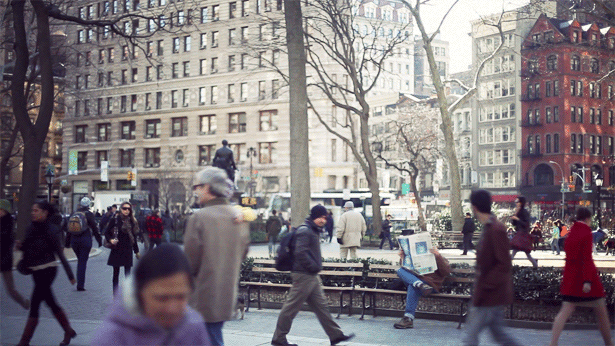

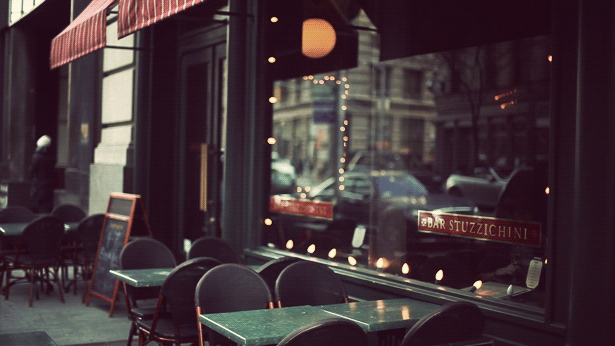
Read more: http://www.dailymail.co.uk/sciencetech/article-1380795/Cinemagraphs-Artists-develop-pictures-movement-stills-level.html#ixzz2SeMsYrZd
Follow us: @MailOnline on Twitter | DailyMail on Facebook
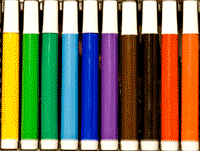

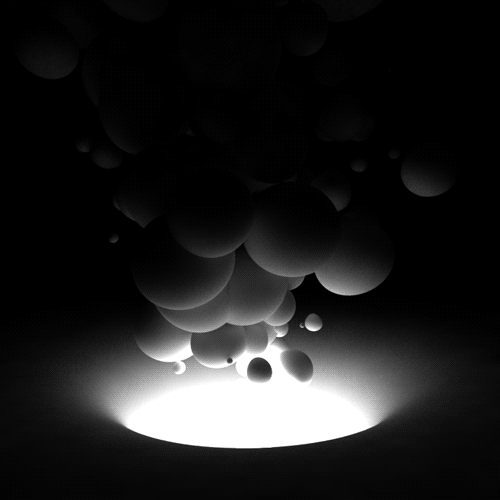
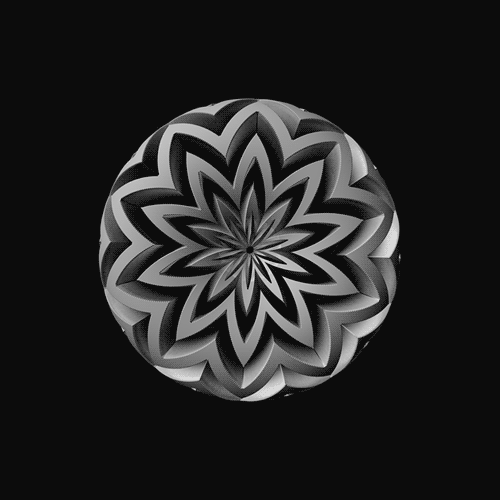


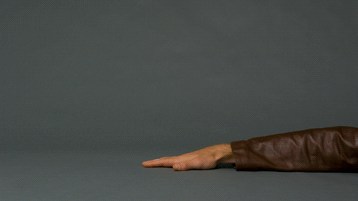
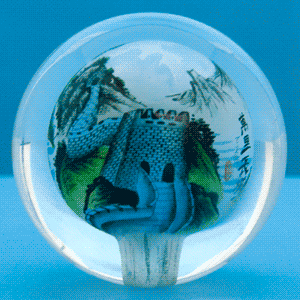

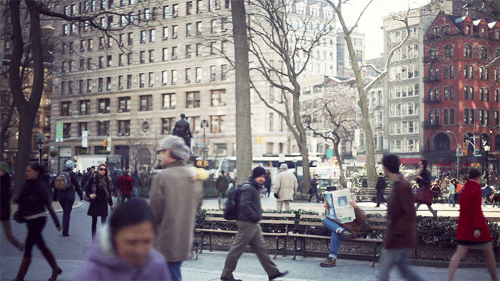

TS: How long did it take you to develop the technique?

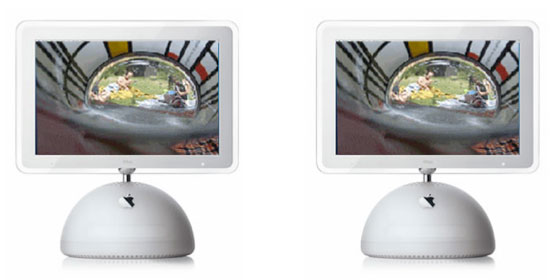
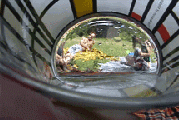

Famed blogger, web strategy expert and technologist Anil Dash has professed his love for Animated GIFs penning about 1500 words on the subject. It’s good to see so many people talking about the file format, especially when these words come from such early web influencers as Dash (thx for the Graphics Interchange Format mention!), though naturally I have a few additional thoughts to add. In particular, I think Dash and I differ on our thoughts about the future of animated GIFs:
















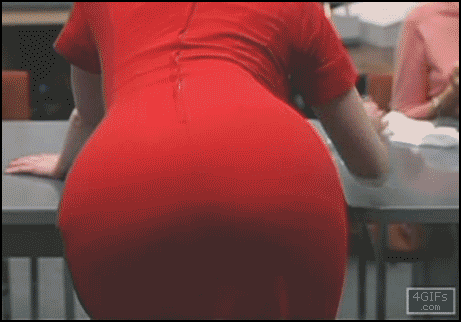
Animated Gifs are Cinematic, But They’re Much More Than Cinema
By Landon Palmer
Over at IndieWire, A.D. Jameson has written a compelling article about whether or not GIFs (the bitmap image format known as Graphics Interchange Format) can be considered cinema. The piece is miles from a imminently clickable gimmick made to start an argument – Jameson’s case is intelligently and thoroughly argued, and he trots out everything from Bruce Conner’s A Movie to Charles and Ray Eames’s Atlas to make it.
While far from a heated question (as Jameson points out, the question of whether or not gifs are movies presumes an argument that does not, in fact, exist), it’s an important one. With something as seemingly simple and trivial as the gif, we can ask not only what something called cinema means in and for the 21st century, but also how moving image communication in the age of the Internet communicates in particularly cinematic terms.
So I offer something of a refutation, or perhaps a clarification: gifs are certainly cinematic, but they are considerably more than cinema.
The YouTube of 1910
Popular modes of moving-image distraction on the Internet present a rich paradox for the cinephile: it both signals cinema’s supposed end (the certain obsolescence of film stock, the portending irrelevance of movie theaters) as well as its humble beginnings. In regards to the latter, sites like YouTube are in some ways a personally-curated descendent of the earliest days of cinema, specifically the vaudeville act or the nickelodeon: the emphasis is on short-form, largely non-narrative, attractions-based entertainment.
Gifs address cinema’s roots, but in different ways from the short-form Internet video. As Jameson’s comparison of gifs to certain avant-garde titles demonstrates, gifs are a popular deployment ofstructural cinema, reducing the potential messages conveyed through images to the mechanics of image-making itself. Jameson situates gifs as cinema because they fall under the rubric of “moving images,” a decidedly broad understanding that places gifs as part of the same trajectory as the photographic experiments of Eadweard Muybridge: the emphasis is on the phenomenon of movement itself.
Perhaps if we say that cinema is not any series of images that are moving, but that cinema is about the movement of images itself (which can encompass anything from conventional linear storytelling to special effects spectacles to the avant-garde), then we can come to a more approximate understanding of precisely what gifs are doing that make them cinematic.
Animated gifs make the viewer/reader aware of the processional movement of images. The frame rate is visible and sound is absent, both of which foreground the fact that we’re witnessing the rapid juxtaposition of still images rather than movement itself, an illusion that cinema routinely hides so effectively. The fact that the same series of images is repeated over and again in the gif reiterates this point ad infinitum.
The Popular Experimental
Thus, Chris Marker’s La Jetee is a productive companion to the gif. Marker’s masterpiece essentially reduces cinema down to its bare elements: still images in succession, strung together with narrative components in order to give these images meaning in relation to one another. By stripping cinema of its movement (would the film’s sole eyeblink qualify La Jetee as cinema according to Jameson’s definition?), Marker’s film makes a case that it’s not necessarily the movement of successive images that constitute cinema, but their juxtaposition. It’s this juxtaposition that causes a general sense of “movement” more broadly – not the lie generated 24 frames per second, but the illusion of images as events moving forward in time, specifically in relation to prior images.
Marker’s film builds in several ways off the Kuleshov Experiment, Lev Kuleshov’s evaluation of images in relation to one another through montage. In the experiment, Kuleshov juxtaposed the same image of a man’s face next to other images (a bowl of soup, a dead child, a woman), and these successive visual associations caused audiences to read different emotions onto the same face (hunger, sorrow, and desire, respectively). The Kuleshov Experiment posited that meaning doesn’t reside in the image alone, but in the ways in which the image becomes contextualized: the logic of movement through juxtaposition, or the assumption that the first image has some meaningful relationship to a subsequent image.

In these terms, gifs do indeed operate cinematically. In the Picard vs. Chunk gif that Jameson revisits throughout his analysis, the punchline is delivered under the assumption that the reverse shot of Chunk exists in relation to the initial shot of Picard: two characters from two disparate narrative universes now co-exist in the same space through the assumptions we carry as conditioned filmgoers to the implied relation between successive images.
However, context is remarkably different in the gif than it is in the examples discussed above. Kuleshov filmed the bowl of food, just as Marker made photographs of the dystopian future of La Jetee. If either of these artists utilized pre-existing images, they aren’t recognizable to us as such now, nor is such a recognition necessary for them to get their respective points across.
By contrast, gifs operate based upon the assumption that a reader/viewer is broadly keyed into popular culture, into other moving images and ideas that exist well outside the scope of the “gif itself.”
A Medium By Any Other Name
Of course, using the existing stuff of culture to make something cinematic isn’t anything new. As Jameson points out, A Movie is made from existing footage – Conner’s inventiveness lies in his use of that footage, not his production of original images. Other experimental films, like George Landow’sRemedial Reading Comprehension, Ken Jacobs’s Tom, Tom, the Piper’s Son, and the careers of Bill Morrison and Martin Arnold, operate through a deliberate manipulation of “found footage” so to speak. Martin Arnold’s* brilliantly clever Life Wastes Any Hardy works comparably to a gif: Arnold plays the footage forwards and backwards in a way that gains new, in this case subversive, meaning.

Plus, cinema has hardly ever been medium-specific. From its integrated origins into the vaudeville shows and World’s Fairs at the turn of the 20th century to early sound era films based upon radio plays to technologies that enable cinemagoing at home, cinema has never been an isolated medium.
That said, while gifs do demonstrate cinema’s fundamentals, there’s something notably medium-unspecific about them. Gifs can’t adequately be described through an exclusively cinematic framework. Take an incredibly provocative gif that Jameson spends a good amount of space on:Fresh Prince dancing atop a crumbling World Trade Center tower.
Neither image assembled in this juxtaposition can be sourced in cinema. Both come from television which, yes, also operates through moving images, but also has the unique ability to broadcast events immediately, which has no equivalent in cinema. That’s where/how this icon of the World Trade Center collapsing gains its media power – through the immediacy made possible through broadcasting. The repetitive cycle of this gif doesn’t point to the cinematic operations of juxtaposition as much as it illustrates the cyclical function of television: through the redeployment of once-live events time and again, we experience the shock of this gif once and, like a violent event in the 24-hour news cycle, we’re subjected to it on an endless loop. This tension between immediate ephemerality and the iconicity of images is unique to television, it has no equivalent in cinema, and this offensive gif is works in part as a result of that particular power.
This argument extends to the operation of gifs more broadly: they infer a viewer savvy in an array media formats, and their meaning is heavily dependant upon the way these disparate images are contextualized. One doesn’t need to be able to source all the images to “get” Conner’s A Movie, but one often has to understand a variety of textual elements to understand something as seemingly simple as a gif.
That’s why it’s important not only to analyze the gifs themselves, but where they come from. One gif tumblog that I’m a fan of is PhD Stress: the life of a queer grad student unfolded. As with any occupation-related gif tumblog, this one operates based upon assumptions that the viewer/reader can key into a variety of texts and structures of meaning: in this case, references to various authors, mentions of specific stages in academic career-making, and (of course) the particular media sources that the gifs come from, which (here) is most often television.
Of course, knowing the source isn’t always essential, but it’s certainly a helpful key into the community of understanding that the gif is playing towards. Arguably, unlike Hollywood, few gifs can speak to a mass audience. Contextual meaning in the gif is hardly exclusive to the movement of images.

When we think too deeply about gifs.
An extraordinary amount of knowledge is assumed even for a series of images that only lasts a few seconds. Take, for instance, the gif of Michael Shannon yelling (above). This appeared yesterday after Shannon’s hilarious spoken word performance of the instantly famous Delta Gamma sorority letter. Shannon is perhaps best-known for his movie roles, but knowing who Shannon is makes up only a small portion of the meaning of this gif, which also assumes knowledge of the sorority letter, the reputation of Funny or Die, et al. Even without the subtitles often used to accompany the ever-silent gif, one can imagine, perhaps even “hear,” Shannon’s voice exclaiming by viewing the moving images alone.
Gifs are certainly cinematic, but they’re hardly just cinema. I say this not because cinema is limiting, nor to suggest gifs are somehow more complex than cinema, but because gifs demonstrate, perhaps even more concisely than higher profile Internet events, the continued blurring of lines between previously distinct media platforms.
What’s your take?
*Correction: the author originally credited Alone: Life Wastes Andy Hardy to Bill Morrison. That film was made by Martin Arnold. Both are awesome, and you should seek out their work.
On the Aesthetics of the Animated GIF
By WM. FERGUSON
How many hours have I spent looking at loops ofacrobatic cats, snowboard stunts, the human insanity recorded by Russian dashboard cameras? The answer, I’m afraid, is many.
The reason? They are without question mesmerizing, in the truest sense; the animated GIF is the digital equivalent of the hypnotist’s swinging watch. But they are not only a novel form; in the brief life of the animated GIF, an attendant aesthetic seems to have emerged.
In a long post called “Are Animated Gifs a Type of Cinema?” on the blog Press Play, A.D. Jameson answers the question posed in his headline: “I’m inclined to argue that they are.” (To his credit, he is quick to add that he doesn’t know of anyone who is arguing that they aren’t.)
Jameson identifies the birth of the genre as the dancing-baby loop made famous by a 1998 “Ally McBeal” episode. (Which goes to show how long ago 15 years is in Internet Time. Can you imagine a television show initiating a meme today?) He argues that since then, the animated GIF has adopted some of “real” cinema’s visual language. Here, he compares a GIF (a loop of Captain Jean-Luc Picard from “Star Trek” machine-gunning a child actor from the movie “Goonies”) with the Bruce Conner film “A Movie”:
These examples edge us closer to the world of video art, or earlier experimental films that derived their effects from juxtaposing footage from different films. . . . Both A MOVIE and these animated gifs employ some common cinematic principles. The cuts create an eyeline match, which make it appear as though the characters are looking at one another, and obey the 180-degree rule (meaning that if you draw a straight line between their eyes, our perspective stays to one side of it).
I’m gratified to learn I’m not simply rationalizing the cultural significance of watching loops of people falling through trap doors. (Actually, that’s imprecise. What I’m watching is a loop of one poor liquor-store customer, doomed, like Sisyphus, to fall endlessly through the same trap door. But I’m nonetheless gratified.)
But as irresistible as I find GIF loopiness, I can’t help wondering if it’s contributing to some future death of narrative. I mean, surely not every human emotion can be rendered in a few dozen repeated, low-resolution images.
And yet it seems to be just about the perfect expression of our primal instincts: delight in reaction shots from the animal kingdom, pratfalls that don’t end in grievous injury, alarmed babies. And the most primal of them all:pornography.
An Appreciation of the Animated GIF and Gif Shop

“Animated GIFs are the web’s vinyl records,” wrote Jamie Zawinski on Twitter a few months ago. It’s a sly but accurate observation. In the face of Flash and streaming video, the animated GIF, which has been around since the 1990s, has refused to fade away. It remains a ubiquitous part of Web culture and inspires countless memes amongst a new generation of Web users. While the underlying technology of the animated GIF hasn’t changed, artists continue to explore new approaches to the form, such as cinemagraphs and the recent animated GIF comics trend.
There are many reasons for the extended reign of the animated GIF, prime among them the form’s emphasis on cycles (or loops). Rhythmic repetition was a staple graphic technique of theatrical animation during the 1920s and 1930s before being cast aside in favor of more realistic approaches to movement. The inherent beauty of cycled movement, which was cheapened by limited TV animation in the 1960s, has enjoyed a creative rebirth with the advent of the animated GIF. The animated GIF is also a remarkably potent form, and combined with good timing, it can deliver a surprising punchline as funny as any comedian’s joke. The British animator Cyriak has perfected this type of animated GIF. Perhaps the underpinning reason for the endurance of the animated GIF is its utter simplicity: it has no sound, generally last less than 10 seconds, and require no technical knowledge to create, thanks to the abundance of gif-making websites.
This brings us around to the latest development in animated GIFs: a new iPhone app (also iPad/iPhone Touch compatible) called Gif Shop. Created by Daniel Savage and Matthew Archer, the app, which costs $1.99, streamlines the GIF making process on the iPhone, and makes it easier than ever for anybody to create their own animation. While it’s possible to make any kind of animation using Gif Shop, because of the app’s integration with the iPhone camera, it lends itself particularly to the pixilation stop-motion technique.
Here’s a quick demo of how it works:
Daniel Savage, the app’s co-creator, foresees a social media component to Gif Shop as well, and believes it can become to animation what Instagram is to photos. “The concept of simply creating animated GIFs,” he writes, “evolved into a service that enables our users to share animated GIFs across their networks with no concern for hosting and file size limitations other services may impose. Since the initial concept, Gif Shop is no longer the first of its kind, but we think there is one key factor the others have missed: simplicity. It is extremely important to us that we take the tedious act of making a GIF and make it as fun and intuitive as possible.”
It’s exciting to see the emergence of easy-to-use animation software for smartphones. These apps have the potential to make the act of animating as second-nature to the general public as taking a photograph. That’s a revolutionary concept, especially when one considers that fifty years ago, there were at best a few thousand people in the entire world who could animate. Most of the people using the Gif Shop app aren’t professional animators, but then again, most people who take photographs aren’t Cartier-Bresson. It hardly matters that every animated GIF be a masterpiece. The real victory is that as more and more people animate, appreciation and understanding for the art form will inevitably grow. That may end up yet being the greatest legacy of the animated GIF.

Animated Beef, 2010
Over the past year I’ve stayed mostly silent when it comes to critical writing. Some of this has been due to lack of time. Some of it to a hesitancy to speak critically of those who are or may be peers. Lastly, some of the most vocal folks are exhausting in their epic word counts! But I’ve been thinking a lot, and have decided that a) I want to write more and b.) I won’t stand by while those with more critically rigorous but divergent views and practices sculpt the terms by which we think of Art, Net Art, and especially the burgeoning field of Social Media Art.
The distinction between Net Art and Social Media Art is important, and will be outlined in a future post. Further, I do not identify as a Net Artist (or a Social Media Artist, for that matter). However they often occupy the same sentence in the conversation. My interest in this series is specific to my practice, but my practice is also driven by what I want the future to look like for art appreciators of all varieties.
By setting out to describe this future, I want to first pause to express my concerns with the present. Specifically, with animated GIF art. On the whole, it is depressingly vapid! Worse, its vapidity has been fetishized by those seeking to define and contextualize this next wave of Internet artists. Over the years I’ve seen thousands of animated gifs. I’ve spent countless minutes waiting for them to cycle through their frames so they can be experienced “appropriately.”
One recent example that comes to mind is the Unknown Pleasures meets Matrix-green animated gif that Paddy Johnson highlighted in her Year Of The Animated Gif post. Beyond occasionally witty one-liners, most of these images do nothing to push how we think. Rather they tend to engage in a sort of post-hipster language. They’re stylized, abstract, and, in my opinion, just plain weak images. Of the non-abstract variety exists an Internet kitsch aesthetic which tend to be ironic, cynical and intentionally crude. Both of these varieties remind me of an article I read in New York Magazine a few months back that described Hipsters as smart consumers but whose cultural contributions were few. Or sloppy, lazy, etc. I would put 95% of animated gifs in this category. Granted the culture is arguable larger/more important than the “product,” however, the product usually leaves me with much to be desired.
Needless to say this is not the type of work I want to make. While some of it is certainly entertaining, I am attempting to make work that is both accessible, challenging, subversive, and most importantly authentic.
I believe that the medium must serve the work, and that the work must havesomething to say, regardless of what medium that is (gif, oil paint, collage, etc). Aesthetics alone, however well stylized or unique, are never enough to carry a great work. A work that transcends its form. While I can’t speak to anyone else’s intentions I can say that I don’t want to spend my time framing images that offer limited cultural capital. I by no means claim that my work always transcends, rather it is an ideal that I am continually striving towards.
To be continued!


2010 is the year of the animated gif. They are everywhere. Tumblr’s Three Frames, a site that posts only gifs drawn from movies on a daily basis is recommended to me by students virtually every time I give a lecture. Fuck Yeah Gifs, and Gif Party are also popular. Images on group artist-run blogs like Nasty Nets and Spirit Surfers have always had a keen interest in the file format and have custom software to better display them. No one does the job better than Dump.fm on the image platform front though, which likely explains the frantic production amongst their users.
Notably, only three or four years ago, gif production amongst artists tended to fall into two categories — found and carefully handmade. Typically the latter were lone painstaking efforts. Yesterday, even a brief visit to the sites listed above made clear that the spectrum of approaches has vastly expanded. The casual gif maker, the careful gif, the multiple gifs arranged to make one giant gif, the artist-made authorless gif –you get the picture. There are a lot.
So why are artists suddenly more interested in the file format? It’s hard to say, but one theory tabled in a recent conversation, suggested a reaction to a decrease in websites and search engines able to handle the file format as a possible explanation. Google image search recently eliminated the integration of GIF’s in their standard image searchs, Facebook never allowed gifs, and tumblr and WordPress can’t handle large gifs or display them well. It’s not difficult to make the argument that artists who use the web as source material need sites that are friendly to the file format.
Given dump.fm’s unique software, the question of how these images move off the site is particularly relevant. The most complicated and engaging gifs now displayed in the site’s “Hall of Fame” can’t be displayed on this blog. Who knows how a gallery would handle the images but I expect that question will be answered shortly. October 22nd, 319 Scholes will exhibit DUMP.FM, a show put together by curator Lindsay Howard. Consider me there.
[CORRECTION: This original version of this post erroneously stated that Google eliminated the ability to search by file format. It also described Dump.fm's platform as specifically designed to handle gifs. Its founder Ryder Ripps notes in the comments that gif use is primarily driven by its user base, not its ability to display gifs.]
Have you ever seen a photo move? Artists develop amazing cinemagraphs that take 'stills' to the next level
By DANIEL BATES
It is, in their own words, ‘something more than a photo but less than a video’.
Two artists have created a new way to to record your special moments - pictures with movement.
The ‘cinemagraphs’ look like still photos but actually feature a subtle area of movement designed to grab your eye and keep you looking. The effect is slightly eerie - but utterly captivating.

Hair-raising: Cinemagraphs may look like stills, but they feature a subtle area of movement designed to grab your eye. These animated photos are the work of Jamie Beck (pictured) and her fellow artist Kevin Burg

Turning a page: The cinemagraphs work by using GIFs, a type of picture format similar to a JPEG which has been around since the invention of home computers but has come into its own with broadband internet
In one shot of a crowded square, bodies are frozen in time, but one man quietly turns the pages of his newspaper.
Another photo of a restaurant terrace is brought to life by the reflection of a taxi going past in the window.
Miss Beck has worked with motion graphics artist Kevin Burg to make the cinemagraphs by using GIFs, a type of picture format similar to a JPEG which has been around since the invention of home computers.
Only now with broadband internet are they bringing it to life with a startling effect.
‘Our cinemagraphs are a way of adding motion to a still image,’ Miss Beck said.

Not as simple as they look: The more complex animated photos take the artists an entire day to pull together
In most cases she shoots the photos and Mr Burg adds on motion-graphics over several hours of painstaking editing.
The more complex ones take an entire day to pull together.
New York-based Miss Beck told The Atlantic magazine: ‘There's something magical about a still photograph - a captured moment in time - that can simultaneously exist outside the fraction of a second the shutter captures.
‘We feel there are many exciting applications for this type of moving image.
‘There's movement in everything and by capturing that plus the great things about a still photograph you get to experience what a video has to offer without the time commitment a video requires.’
She added that sharing websites such as Tumblr have been essential for helping them publish their work and getting them an audience.

Eerie effect: Cinemagraphs are calming to watch as only one area moves - and they are silent
Read more: http://www.dailymail.co.uk/sciencetech/article-1380795/Cinemagraphs-Artists-develop-pictures-movement-stills-level.html#ixzz2SeMsYrZd
Follow us: @MailOnline on Twitter | DailyMail on Facebook


Back in the early days of the internet, animated GIFs were the bane of just about everyone. Their annoying, jarring graphics and often painfully bright colors were enough to make anyone crazy. Particularly irritating was when they were used as avatars in chat rooms or forums, and we’d have to watch their stupid dancing polar bear dancing or sneezing kitten a thousand times before finally just leaving the page in frustration. Some people still use the unfortunately annoying animated GIFs, but there’s a whole new crop of artists who are using this long-maligned vehicle to express their creativity.


The above GIFs, from artist David Ope (also known online as dvdp) are markedly more mature than those that we raised in the 80s and 90s remember. Their existence doesn’t seem to center on the desire to draw attention or to frustrate; rather, they are simply beautiful, mesmerizing pieces of art.


There’s a certain amount of nostalgia in these pieces; it seems to suggest that the creators grew up in the era where the animated GIF was an ever-present Web element. And although it’s largely fallen out of favor in Web design (thankfully) this new, more mature generation of the animated GIF is taking it in an entirely new, extremely creative direction.


That’s a common theme in this new generation of animated GIFs: they are more art than novelty. Anyone who has seen a tiled animation used as a background for a web page knows that the constant looping motion can quickly become intolerable. But the animated GIFs being created today are more of an underground art movement than a momentary distraction. The above animations from Sweet GIFs come from several different contributors, indicating that there is a thriving community of artists and designers dedicated to preserving and promoting the image format.

Jamie Beck & Kevin Burg have been making quite a splash this year with their "cinemagraph" technique, combining still photography and video to "unfreeze" a photo in time. The results are stunning, and show that there was more potential in the old animated .gif format than had yet been realized.
We caught up with Jamie and Kevin, who let us in on their process.
Turnstyle: Animated .gifs have long been the territory of goofy forum signatures and internet memes, what caused you to take the idea of animated photographs up to the level of art?
Jamie & Kevin: We wanted to tell more of a story than a single still frame photograph, but didn't want the high maintenance aspect of a video. In preparation for Fashion Week we were trying to figure out a way to show more about what it was like being there, so cinemagraphs were born out of a need to tell a story in a fast digital age.

The basis for these is always a still photograph which is why they maintain the artistic approach and visual style of Jamie's still photography. What we strive to capture is the moments before and after a photograph is taken.
TS: Why "cinemagraph"?
J&K: There's a cinematic quality to them in both the way it captures a moment as well as the coming together of still imagery and moving imagery. "Cinemagraph" represents, in a single word, what the images represent visually. Coco Rocha put it well: "More than a photo, but not quite a video."
TS: Technically speaking, how are these different from animated .gifs? I'm perceiving a lot more frames of animation for one, but is that just my brain filling in the blanks? It also feels like the animated parts are isolated from the rest of the composition.
J&K: An animated .gif is usually a sequence of stills pulled from video, animated art, or other imagery that is repurposed into a .gif. What we do is different because it's a traditional still photograph with a moment living within it. For us it's less about the .gif format -- that's just the vessel by which it's best to deliver them on the web, although the limitations of the format have been very influential on the visual style of our images. The .gif format itself is ancient by internet standards but much like photography people are always finding interesting new ways to communicate within the confines of existing formats.

TS: How long did it take you to develop the technique?
J&K: Kevin has a background in motion graphics and has been playing with the .gif format since getting a computer in the mid 90s, but this particular technique started taking shape about a year and a half ago. It was the coming together of Jamie's photography and this technique that made it what it is currently.
TS: How do you choose a subject for a cinemagraph?
J&K: A cinemagraph always starts with a photograph. As a rule of thumb, we only create a cinemagraph from subject matter that would also make a good still photo. Often times we'll have an idea for a cinemagraph that captures the essence of the subject through an action or moment in a way that a photograph can't. When we decide to take a still photograph, and make it into a cinemagraph, it's when there's more to the story than can be captured in a still frame. We really feel this is an opportunity to look at everything we know in the world and show it in a new way, which is an extraordinary opportunity as artist and visual creators.
J&K: A cinemagraph always starts with a photograph. As a rule of thumb, we only create a cinemagraph from subject matter that would also make a good still photo. Often times we'll have an idea for a cinemagraph that captures the essence of the subject through an action or moment in a way that a photograph can't. When we decide to take a still photograph, and make it into a cinemagraph, it's when there's more to the story than can be captured in a still frame. We really feel this is an opportunity to look at everything we know in the world and show it in a new way, which is an extraordinary opportunity as artist and visual creators.
You can see more cinemagraphs at Jamie's Tumblr photo blog From Me To You.
Graphics Interchange Format At Denison University’s Mulberry Gallery
by Paddy Johnson
I’ve curated another show. Graphics Interchange Format is a survey of animated GIFs and it launches this Friday Denison University’s Mulberry Gallery. I’ll be heading to Ohio this afternoon for the install — uber nerds can follow me on twitter as I tweet up a storm about the installation process. The slightly less nerdy, uber-nerd can simply read the press release I’ve written up on the subject below and click on the links. GIFs are an important medium. If this show is a success — and I think it will be — it will demonstrate that. A website for the show will launch next week.
_____________________________________________________________________________
Since the early days of the web, users have been posting animated GIFs. Once synonymous with shoveling construction workers on parked domains, these moving images now more commonly find their way to Tumblr blogs. Now GIFs are more frequently appropriated images than hand drawn, but like their predecessors, are still frequently annoying.
They attract attention. They flicker and undulate. They stutter. Graphics Interchange Format (GIF unabbreviated) surveys a small subsection of fine art workers within this growing culture of image-makers. Focusing on work that engages both the language of the Internet and fine art, this exhibition aims to articulate the value of the GIF in the context of the gallery. Participating artists include Duncan Alexander, Kevin Bewersdorf, Saul Chernick,Petra Cortright, Stephanie Davidson, dump.fm, MTAA (Tim Whidden and Michael Sarff),Lorna Mills, Tom Moody, Marcin Ramocki, and Spirit Surfers.

Like any product of the Internet, sampling and remixing is a dominant method of working with GIFs and a theme in the show. Artist collective MTAA's “Simple Net Art Diagram” is a prime example of this, their image created and released to the public domain for remixing in 1997. An illustration of two computers with a red flashing lightning bolt between them, the picture locates communication and exchange as the center point of art. Of course, artists don't generally license their GIFs — Internet users usually assume they can do what they want with them — but the gesture was an invitation to converse. Now dozens, if not hundreds, of “Simple Net Art Diagram” GIFs exist.
One recent response to “Simple Net Art Diagram” is an untitled GIF by Kevin Bewersdorf. Made in 2008, Bewersdorf locates “art” as the energy that originates from within the artist and is exchanged by makers through their computers. “Mandala”, a related work by the artist produced in 2008 picturing a meditating Bewersdorf surrounded by bouncing GIFs, demonstrates a clear connection to this philosophy. “Bewersdorf's GIF incorporates hundreds of independently moving found GIFs with very little compression (a technical accomplishment achieved with the help of Paul Slocum), allowing the artist to depict each component with great clarity.” The original video was full screen but the GIF version is smaller and it’s still amazingly detailed.
The same year, Bewersdorf founded Spirit Surfers with Paul Slocum, a group image blog, in which a small number of invited artists post regularly. In contrast to MTAA, a collective that very squarely identifies what they do as art, Bewersdorf considers the posted images neither art nor non-art.
But, in a sense the very structure of the Spirit Surfer blog resembles art: all posts are separated into “boons” and “wakes” — or, perhaps, “objects” and “context”. The former are treasures brought back from a day of surfing the net, the latter images, text, or video telling us where the boons come from. Whether or not all posts should be labeled art is, of course, up to Spirit Surfers's contributors to decide.
“Where is it?” a video produced with GIFs made by Spirit Surfer Marcin Ramocki is set to electrified music made by Paul Slocum. The video reflects Bewersdorf's philosophy by including a thumping page describing the heart and kidneys as the main transformer of chi energy, though the narrative of the piece as a whole remains intentionally oblique. It's filled with intuitively connected images: rotating blocks; Chewbacca under a series of flashing weather icons; glittering poodles.
If this method of organization doesn't sound particularly mystical, that's because it's not. While artists like Ramocki and Bewersdorf might have varying levels of interest in what happens to one's soul when surfing, the idea that art itself might have unexplained powers is often looked at with skepticism. This practical take on work often shows up on Dump.fm, a popular image chat room used by artists and other creative types. The site plays host to variety of members — some infrequent visitors, others near-permanent fixtures — only a few of whom use the site to develop their own work. The site's newly launched daily hall of fame both functions as a digital sketchbook and highlights the temporal nature of dump.
Unsurprisingly, two of the site's more active members – Tom Moody and Duncan Alexander - also have work in the show. One of three GIFs by Moody included in the exhibition is a collaborative GIF made with Dump user Frankhats (Joel Cook); a machine drawn from a science animation. Alexander's Brion Gysin gifs were made in response to Moody's “Internet Circulation Project”, a call to artists, to remix two collages Gysin made in collaboration with William S. Burroughs. The point was to disprove critic Ben Davis' assertion that Gysin's work was part of a vanishing world.
Gysin's work is in fact quite relevant to artists whose source material is largely found online. In particular, Alexander makes work about the physical processes behind vision and perception. Dreammachine, a strobing light show by Brion Gysin on view at The New Museum in the summer of 2010, inspired the artist (and others) to create a series of GIFs that achieved the same synaptic effect.
The throbbing lines of Moody's OptiDisc create a similar effect. Like much of his work, the image embodies the ideals of modernism, generating a push-and-pull between emotional awe and reason. Their emotive qualities last only as long as Moody allows a reverence for technology — in Moody's world modernism is only an afterimage, its spirit eventually replaced by mechanical functionality.
Moody’s, Gysin’s, and — by proxy — Alexander's interest in the psychedelic suggests in part a desire to leave the body. It's no surprise that this might be relevant to artists who spend enormous amounts of time in the virtual world, though this interest takes many forms. Stephanie Davidson, for instance, is interested in creating vaguely creepy GIFs incorporating Ouija boards, black magic, and spirits from the afterlife. Cotton balls turn into cats, a coffin emits rainbow gradient gas, and an aluminum blanket moves as if possessed. They are macabre jokes depicting a world in which the ubiquity of cultural production and the online marketplace produce levitating sandwich trays in corporate boardrooms. The dead don't eat much though, which suggests Davidson thinks our efforts are not well directed.
Also investigating the afterlife are Saul Chernick's Renaissance-inspired images of dancing skeletons with lutes. His take on the subject, though, seems more celebratory than one would think: in one work, a frog sits on the skull of one dancing skeleton while happy snakes run through two others. Inasmuch as these works are about death, they are equally about production and distribution; Chernick based his animations on some of the first cheap and accessible prints of their kind, much like gifs.
While Chernick draws upon printmaking, Petra Cortright takes inspiration from the tradition of collage. Combining videos of the natural world with windows from a PC operating system, the work looks unfamiliar despite its commonplace elements. After all, we have all seen images of river water and file frames — what's disconcerting in Cortright's work is that they have been arranged in such a way that the operating system looks corrupted. That none of the links between GIFs are marked only adds to the disorienting experience.

Lorna Mills, Focal, 2007, animated GIF

This work doesn't concern itself with whether art has any real power, a subject Lorna Mills broaches. Her piece Focal showcases duplicate shots of a family picnic distorted through the bottom a transparent plastic cup. Mondrian's famed painted patterns adorn the mug, yet the family looks no more special as a result. Here art is just a cheap wrap.
In another series of GIFs picturing twirling Olympic ice dancer, Mills crops out squared-off areas around the dancers' moving arms. The result creates depth. Mills' figures look as though they are being viewed through moving rectangular shapes, the white of a page now resembling gallery walls. In both cases, Mills creates a frame through which her GIFs should be seen. This serves a number of purposes, not the least of which is reminding the viewer that her works require a longer look.
The same could be said of all the art in Graphics Interchange Format, which not only requests but also deserves our attention. After all these gifs aren't just blinking images, they are the beginning of a new conversation.

Famed blogger, web strategy expert and technologist Anil Dash has professed his love for Animated GIFs penning about 1500 words on the subject. It’s good to see so many people talking about the file format, especially when these words come from such early web influencers as Dash (thx for the Graphics Interchange Format mention!), though naturally I have a few additional thoughts to add. In particular, I think Dash and I differ on our thoughts about the future of animated GIFs:
What’s more important than where GIF has been is where it’s going. As noted above, Tumblr alone has seen a renaissance of the GIF format, amplified by the boundless creativity of image manipulators on communities like 4Chan and B3ta. Jamie Beck’s GIF animations on From Me To You have been a Tumblr phenomenon, showing how truly elegant the format can be. If we don’t, remember me and three framesdemonstrate the power of film through the lens of GIF’s delightful constraints, the former with a mesmerizing fluidity and the latter with a jerky intensity. Even beyond the capture or transcoding of other video works into GIF format, artists are starting to work with GIF on its own terms. Earlier this year, the New York Times illustrated a story with an animated GIF for the first time ever (not counting stories that were about creating GIFs), showing that this uniquely expressive format is truly coming into its own as a mainstream animation format.GIF reaches perhaps its inevitable apotheosis with Physical GIF. Greg Borenstein and Scott Wayne Indiana’s brilliant Kickstarter project promises to turn animated GIFs into actual zoetropes you can display on your desk or coffee table. I saw a prototype of the idea a few months ago, and it left a lasting smile on my face. Go support the project!
Two points: One, as I’ve mentioned previously, while Jamie Beck’s images have a blinking postcard type of appeal, the same question occurs to me while looking at them as did last night while watching Werner Herzog’s Forgotten Cave of Dreams in 3D: What does this effect add to the narrative that the image itself doesn’t already tell me? The answer is nothing. It’s just a cheap parlor trick.
Two, I think there’s some flaw of logic in naming something that isn’t a GIF as a GIF’s highest point of development. Personally, I only think we’ll see this when it becomes standard for web software to let users easily arrange GIFs side by side, in grids, and other such arrangements. Also, if load times were never an issue, I’m sure we’d see a lot more complicated GIFs.
Anyway, assuming the US government doesn’t ruin the world economy next week, I’m guessing faster Internet connections and better image management tools are in our future.

Tom Moody, OptiDisc, 2005
The Affect of Animated GIFs (Tom Moody, Petra Cortright, Lorna Mills)
[Images by the artists mentioned can be found here:
Since the early 1990s, artists have chosen the internet as a medium, an environment and a forum. While some internet artists also maintain a gallery practice, the conditions and conventions that inform meaning in online art remain in many ways distinct from those of the off-line artworld. Internet art — inherently ephemeral and infinitely reproducible — eludes commodification and largely operates independently of the art market.[1]In the online environment where acts of creative self-expression are the norm, the boundaries between artists and not-artists that confer status and hierarchy in the gallery and museum system are largely immaterial. Even among niche groups of online practitioners who self-identify as artists, the culture of internet art regards the agency of the viewer on a par with that of the artist. In most cases, viewers are also producers. Many online artists, such as myself, operate through the medium of the blog format, which allows for a hybrid practice blending art production with art criticism, cross-promotion and dialogue.
Most criticism about internet art takes place online in comment threads on individual blogs or on institutionally supported websites such as Rhizome.org that provide discussion forums. The discourse tends to revolve around debates (often heated) about the appropriate use of various technologies in relation to both formal concerns and political issues inherent to open source ideology. There has been very little critical discussion about the affective qualities of various digital media.
What do I mean by affective qualities? Most theorists who deploy the concept of affect draw from Brian Massumi’s definition of affect as a physiological state of intensity.[2] Following from Massumi, affects are understood to be fluctuations of the body’s autonomic response system — precognitive, asignifying and distinct from the qualifying, meaningful stages of emotional response.[3] As a quantifiable function of physiology, then, the concept of affect has a potentially essentializing and universalising role in its application to cultural critique. But at the same time, affect retains a dimension of contingency, because the term is derived from theories of consciousness that refuse the Cartesian dualism of the mind/body split. Massumi explains,
- [V]olition, cognition, and presumably other ‘higher’ functions usually presumed to be in the mind, figured as a mysterious container of mental entities that is somehow separate from body and brain, are present and active in that now not-so- ‘raw’ domain. Resonation assumes feedback. [...] The body doesn’t just absorb pulses or discrete stimulations; it infolds contexts, it infolds volitions and cognitions that are nothing if not situated. Intensity is asocial but not presocial…[4]
Affect is of the body, but the body is conjoined with mind, and the entire organism is understood to be entangled with its cultural contexts. So, while any specific affective response is particular to the moment and the person who is having the experience, affect can also be theorized at the level of the collective if it is taken into account that cultural conditions have a normative function that may exclude certain modes of response from collective models. Affect is particularly applicable to the online art environment, where relationships between body and mind are fraught, and where dynamics between individuals and collectives are both immersive and politicized.
How do the affects of software technologies inflect interactive online art experience? In this paper, I will specifically examine the affects of the animated GIF (short for Graphic Interchange Format), a ubiquitous graphic file format used by artists and non-artists alike. If any website contains an animated element that is self-contained, chances are high that it is a GIF. GIFs are small, simple files, easy to create and quick to download, making them widely accessible to a range of browsers and system speeds. I propose, however, that it is the affective qualities particular to animated GIFs that make them truly popular.
Massumi describes affective intensity as a temporal sink, a moment of incipience before action is taken. In GIFs, such moments are looped, extended and repeated between every frame. For Amy Herzog, the suspended moment of affect is potentially political, allowing for intuitions to emerge that cut across the grain of cultural norms.[5] Do animated GIFs facilitate such agency? In order to address this question, I will discuss the affective qualities of three GIFs by internet artists Tom Moody, Petra Cortright and Lorna Mills. I will briefly delineate the cultural context surrounding GIFs and I will then analyse the three artists’ GIFs according to Richard Dyer’s theory of non-representational codes, Margaret Morse’ poetics of video installation, Brian Massumi’s notion of affective intensity as a temporal sink, concerns about affect and agency raised by Susan Buck-Morss and Sianne Ngai, concerns raised by Elizabeth Wissinger about affect in an “attention economy,” and concerns raised by Michelle Henning about the reification and standardization of persons in a technologized society.
The GIF is an image format designed by Compuserve and released in 1987.[6] Controversy over GIFs arose in 1994, when Unisys, the patent-holder, unsuccessfully attempted to regulate their use.[7] Because GIFs have been around so long, their contemporary use has a “retro” feel, as opposed to more glamorous programs such as Flash. In addition, the GIF controversy has meant that their use is also somewhat political and can indicate a commitment to the long-standing open source, anti-copyright activism of online producers. Artist Tom Moody explains,
- Animated GIFs have evolved into a kind of ubiquitous ‘mini-cinema,’ entirely native to the personal computer and the World Wide Web. Almost anyone can make one and almost every browser will read them. In other words, no YouTube compression, no wait time, no subscriptions or proprietary formats to view, and they can be made in the most elementary and cheap imaging programs. They are the purest expression of the democratic web and along with JPEGs and PNGs comprise its most authentic visual language.[8]
Both somewhat retro and somewhat activist, the animated GIF is appealing to many internet artists because it signifies an anti-corporate agenda as well as a kind of “truth to materials” commitment to technologies that are elegantly designed for democratic online use.
Since the early days of internet art, online artists have participated in challenging the museum and gallery hierarchies of off-line art systems.[9]The vast majority of GIFs (as well as YouTube videos, Flash animations, RealAudio sound files and a host of other cultural digital formats) are used by creative producers who do not self-identify as artists. Animated GIFs are created, collected and displayed by everyone from Christian website designers,[10] to antique technology buffs,[11] to culture bloggers.[12]For online artists, then, the use of the animated GIF also demonstrates a willingness to plunge into the vernacular of online production, blurring boundaries between art and non-art categories. Most analyses of animated GIFs discuss their signifying functions according to their specific contents and/or their historic, socio-political role in the culture of online production, but as noted above, their affective qualities are rarely, if ever, addressed.
The affective qualities of artists’ animated GIFs emerge in part from the context of their production. GIFs are designed to be viewed at home, in private, by people who are sitting at their computers. Yet at the same time these people are immersed in the hybrid, public/private environment of a personal computer connected to the collective public commons of the internet. The viewing distance — the space between the face and the monitor — is very tight. GIFS are simultaneously “in your face” and in your mind, their affects continuous with the immersive experience of daily internet use. However, just at Richard Dyer describes the songs in Hollywood musicals as “self-enclosed patterns”[13] set apart from the narrative structure, animated GIFs — like casual online puzzle games with their addictive audio and visual rewards — provide brief moments of aesthetic affect, diversions that are set apart from the running narrative of the work day.
Each of the artists that I will be discussing, Tom Moody (New York), Petra Cortright (Berlin) and Lorna Mills (Toronto), has a gallery practice as well as an online practice. Each uses the GIF specifically but not exclusively. Moody and Mills both have blogs on which they post writing about, and examples of, art by others alongside their own creations.[14] All three post collections of GIFs by others, sometimes remixed and manipulated.[15] They are all active participants in the online culture of exchange, and they are to some extent in dialogue with one another.
Tom Moody’s GIF OptiDisc[16] is a mesmerizing series of concentric circles — red, blue and black — that seem to emanate and recede from a central point in a short, looping animation. It is slightly hypnotic, inducing a near trance-like state almost immediately upon viewing. Richard Dyer’s model of affective non-representational codes in Hollywood musicals — colour, texture, movement, rhythm, melody, camerawork — can be applied to OptiDisc with some variations. The piece makes use of colour, movement, and rhythm, as well as a new category specific to GIFs — smooth versus jerky motion. There is no sound, and more importantly, there is no camerawork. While the motion takes place along the depth axis, and seems to envelop the viewer, there is no sense of a representational point of view. Furthermore, because the technological interface of the GIF is seamless with the internet experience — clicking and browsing web pages — the affective codes are felt immediately as part of the viewer’s environment without the distancing mediation of screened film or video.
Dyer describes the way that affective codes work “at the level of sensibility,”[17] by which he means, “an affective code that is characteristic of, and largely specific to, a given mode of cultural production.”[18] Non-representational codes, for Dyer, do have iconic resemblance, but it operates at the level of “basic structuration.”[19] The patterns of the artwork are analogous to the physiological patterns of sentience in the viewer.[20] Engaging the viewer’s perceptual system directly — within the codes and conventions of online production —OptiDisc is very present, functioning more like a felt sensation than a merely visual observation.[21] In this way OptiDisc operates in the “here and now” as Margaret Morse might say, but without the institutional structuring of the art museum to enframe and stage the experience.
In her essay on video art installation, Morse identified a limitation to the affective potential of the medium; video must take place in time. The “temporal unfolding”[22] of installation video is usually cyclical, looping so that visitors may enter at any point in the cycle and exit at will. Morse explains that “this unfolding is incompatible with taking in visual objects all at once… .”[23] She wonders what would happen to the “notion of experience in transcendence”[24] if “one were to reduce temporal unfolding to the barest minimum”?[25]OptiDisc provides an opportunity to address the question.
The loop in OptiDisc is very short, and the entire sequence can be grasped in a matter of seconds. The cyclical repetition is itself integral to the perception of the work, and the viewer’s hypnotic engagement is reinforced as the animation repeats again and again and again, creating an immersive, numbing effect. In contrast to video installation, the experience of the animated GIF is both personal and disposable. Very little investment is required to approach the work — there is no travel time to a gallery nor any admission fee — and leaving is a simple matter of clicking the mouse. It is entirely up to the viewer to determine how much time to spend with the piece, and it is the value of the affective experience alone — the neurological rewards of watching the animation — that make up the criteria for lingering or leaving.
The intensity of affect in most animated GIFs — and OptiDisc is a prime example — is partly due to their jerkiness. The goal of most cinematic animation is to render motion as smoothly as possible. The goal of the animated GIF, on the other hand, is to employ as few frames as possible, in order to keep the file size small and the download times speedy. As a result, there are noticeably larger-than-usual gaps in the illusion of motion. Margaret Morse describes a similar phenomenon in her essay when she discusses Beryl Korot’s Dachau. There is a rhythmic pattern to the multiple-monitor video projections, but it is a little off kilter.
- I have come to think of this possibility for repetition, contrast and migration of images across a shape as a poetic dimension of video installation: that is, it is a practice that deemphasizes the content of images in favour of such properties as line, colour, and vectors of motion, with content of their own to convey. The choreography of these properties is another kinaesthetic dimension of transfor-mation.
- The transformation from monitor to monitor, from two to three dimensions and back again, is most visible when these ontological levels do not match and the conceptual is transformed in its passage through various material manifestations.[26]
Morse identifies that the affective physiological dimensions of rhythm and pattern are most apparent when they don’t exactly match up. OptiDisc has only nine distinct frames that repeat backwards, for a total of 18 frames per loop. It only has four colours, including white. The artist has carefully timed distinct passages of motion between the various coloured rings so that they do not travel at exactly the same rate. The jerky gaps between frames further grab the viewer’s attention. The moments of suspension are very short, but they are much longer than those of most animated sequences. When watching this jerky motion, the viewer’s brain becomes actively engaged in the perceptual process, working to fill in the gaps in the action, creating a sense of motion that is never quite seamless, and thus never quite complete as an illusion.
Brian Massumi describes affective intensity as a “state of suspense, potentially of disruption. It is like a temporal sink, a hole in time… .”[27]This is a moment of incipience, before action is taken, before emotions qualify and retroactively determine the affect. In animated GIFs, the gaps in action between frames extend the affective suspense. They are small enough to suggest motion, but large enough to create a perceptible gap, which means there is plenty of time for the affect to take hold. As Mieke Bal might describe it, the animated GIFs function like cinematic close-ups — “abstractions isolating the object from the time-space coordinates in which we were moving as if ‘naturally.’ A close-up immediately cancels out the whole that precedes it, leaving us alone, thrown out of linear time, alone with a relationship to the image that is pure affect.” [28] Unlike close-ups in cinema, however, animated GIFs function without a “whole” — there is no ongoing narrative for them to be juxtaposed against. If, as inOptiDisc, the affect is strong and virtually uninflected by signification it can induce a light trance, taking over the perceptual system by temporarily shutting down emotion and cognition.
This kind of cognitive stupor can be pleasurable, but it does raise some concerns. Amy Herzog talks about the political potential of the affective pause in feminist film as a moment of becoming.[29] But what if the becoming never comes? What if the affective intensity remains arrested, and is never collapsed into action or emotions? Granted, many animated GIFs carry more signification than OptiDisc and even in this piece there are references — such as an allusion to Jasper Johns’ target paintings — that may eventually emerge and break the spell. But the endlessly looping structure does enhance a kind of “anaesthetic” state, as Susan Buck-Morss might describe it. “The problem,” Buck-Morss suggests, “is that under conditions of modern shock — the daily shocks of the modern world — response to stimuli without thinking has become necessary for survival.”[30] In a culture that depends on citizens’ passivity — and the contemporary context of late capitalism would certainly apply — aesthetic products and media may be designed as phantasmagorias, which, as Buck-Morss explains, have the “effect of anaesthetizing the organism, not through numbing, but through flooding the senses.”[31] The zoned-out state of mind induced and extended by digital media such as OptiDisc may be an affect that mitigates against the agency of enhanced perceptual engagement.
The suspended affect of animated GIFs is also reminiscent of Sianne Ngai’s concept of a “noncathartic aesthetic: art that produces and foregrounds a failure of emotional release.”[32] Indeed, Ngai is specifically interested in animation as a racialized “translation, into affect, of a state of being puppeteered” resulting in a “predicament of suspended agency.”[33] In applying Ngai’s concept of “stuplimity” and Buck-Morss’ “anaesthetic” to the affect of animated GIFs, however, it is important to remember that the internet is not a broadcast medium. Particularly within the context of online art practice, almost all viewers are in some way also producers, and animated GIFs operate in a culture of exchange. While distinctions between cognition and affect may be enhanced and emphasized, agency is always implied. I believe that it is the mounting impulse to participate: to re-create, remix or otherwise respond to the GIF under observation, that eventually breaks the spell of affect and leads the viewer into action.OptiDisc, for example, has been appropriated and reposted, often without credit, by scores of other internet users. For Moody, this viral appropriation — the exercise of agency by others on his work — is a token of success, and he has even mounted a gallery exhibition of prints from 60 screen shots of OptiDisc as it has appeared on other websites besides his own.[34]
In contrast to Moody’s 18-frame, 4-colour OptiDisc, Petra Cortright’s untitled (hands1.gif) GIF[35] has 61 frames and 124 colours which means it is a larger file, longer to load, possibly requiring a faster system, and is thus intended for a slightly more specialized audience. It is comprised of screenshots taken while someone, possibly the artist herself, is using a 3-D modelling program to animate a human hand. The hand is being rendered as a wireframe, with intricate patterns, codes and surfaces. Cortright’s GIF includes haphazard glimpses of tool bars and cursors as well as intentional glitches in which the 3-D coordinates are suddenly set way out of whack causing the hand graphic to mutate into wildly unrecognizable shapes. There is a multi-layered reference to puppeteering here. The piece depicts a puppeteer at work creating a high-tech, 3-D model. At the same time, the puppeteer is herself a puppet, her high tech efforts animated in a very funny selection of comparatively low-tech frames, showing mistakes and gaffes and flying in the face of the mainstream animation conventions.
One of the affects of Cortright’s GIF is humour. When looking at 3D graphics we expect to see smooth forms spinning around seamlessly in space. Instead, here we see excess, the carefully rendered form of the hand breaking out into all kinds of disturbing and surprising shapes. The images on the screen grabs that make up the GIF look very sophisticated, but the software used to create the GIF is not. Most computers come with the capacity to take a screen shot, and GIF building can be done in a matter of minutes with a variety of easily downloadable, open source, freeware or shareware programs. The piece is using an accessible, relatively transparent technology to poke fun at the pretensions of high-tech illusion.
In order for viewers to get the jokes, Cortright’s hand GIF requires more insider knowledge than Moody’s OptiDisc, and it has a higher level of signification, passing ironic comment on graphic conventions. These meta-levels of content— along with the large file size — make Cortright’s hand less desirable for appropriation and re-use than Moody’s OptiDisc, and it has not “gone viral” in the same way. But this GIF did attract attention — from Moody and Mills among others — and helped launch Cortright’s reputation as a serious and notable online artist. The meaning of the work, and to some extent its affective impact, depends on viewers who themselves make GIFs, or at least understand the process with enough agency to see how the artist is both invoking and confounding her own agency. In this work, the collective dimension to the practice of sharing animated GIFs is an inherent aspect of its full affective resonance.
While animated art GIFs may induce a kind of stupor, they also address viewers as participants engaged a collective discourse. For those viewers who are also producers, the agency of making GIFs is entangled with the sensation of watching (and collecting) them. To my mind, the agency implied in this collective experience of making and re-mixing GIFs goes a significant way towards assuaging worries about the potentially disempowering aspects of their anaesthetic qualities.
However, while the blossoming of collective artistic agency in animated GIF production is exciting and positive, serious concerns remain about the technologized environment in which this activity takes place. In her essay on affects in the fashion modelling industry, Elizabeth Wissinger shares concerns with Patricia Clough about the commodification of affect in an “‘attention economy,’ in which an infinite expansion of images is met with a finite capacity for human attention.”[36] In the affective labour of modelling competition between images means that the works which are the most attention grabbing become the most valued. The same applies to a great deal of online GIF production. Many animated GIFs exploit the affective intensities of sex, violence, animal cuteness and excessive “bling”[37] to attract attention and generate a kind of currency in a specialized zone of immaterial affective labour, where images are commodified, collected and even fetishized, but the content providers are rarely, if ever, getting paid.
Lorna Mills is an artist who revels in the irreverent excesses of GIF culture, collecting and manipulating found GIFs from the most offensive and profane to the most abject and mundane. In her original GIF work, however, she creates contemplative animations that, unlike most other art GIFs, can be emotionally affecting. While Mills is deeply involved in the collective exchange and manipulation of found imagery, she will also often use her own video footage. She breaks the video down into a series of stills, reverse-engineering high-tech smooth motion in favour of the jerky motion inherent to GIF technology. Mills heavily manipulates the images, stretching the frame, pixelating the resolution, fragmenting and isolating specific movements and gestures.
In Conrad Rodney—a GIF compilation of her uncle playing cards[38]—Mills has added a new temporal element by making the piece extend beyond the boundaries of the monitor screen. Unlike the near instantaneous perception of Moody’s OptiDisc, viewers of this piece must scroll up and down in order to see it in its entirety. Because Mills stacks a series of GIFs together in a block, the specifics of each sequence are hard to follow. An elderly man is playing cards, his movements and facial expressions becoming more than a set of actions and images, combining into an affective miasma of gesture and mood. The result is an evocative portrait that feels more like being with the person at close range than observing him from a distance. He plays confidently without hesitation. His face is alert and slightly self-mocking. He seems like fun to be around. And yet at the same time it is hard to get a fix on him. If they were broken out into individual segments, unstretched, unmagnified and separated from one another, each GIF element would be more like video — easier to grasp perceptually, and easier to dismiss as mere documentation. The final series, however, evokes a poignant, melancholy tension between presence and loss. Like all GIFs, the jerky gaps in the movement add to the intensity of the perceptual engagement, but here they also signify as missing elements, small gestural moments that might have told us more about the man they would have depicted, were they included in the flow. And, yet, if the sequences of motion were represented in their entirety, the precious, fleeting nature of each moment would be less apparent.
As in any artistic subculture, there are those who produce spectacles that demand attention, and those who quietly go about their work hoping for a reflective viewer who will take some time to engage. And there are some, like Mills, who apply both strategies and use them at different times. Common to all animated GIF artists is a dissolution of the status of individual authorship, and the sense of participating in a collectively generated exploration of affect.
Michelle Henning reminds us, however that interactivity has its darker side. She cites Lev Manovich’s concern that computer technology plays into a “modern desire to externalize the mind.”[39]
- Computer interactivity maps our own thought processes onto those already written into the software. It models certain ways of thinking, or certain ways of understanding our own cognitive practices: to click is to make a choice, to follow a link, to associate one event of piece of information with another. This process of the “externalization” of the mind closes the gap between subjective mental processes and objective, machinic processes. In this sense, like Taylorism, it hooks people and bodies up to machines, making people “thinglike.” This argument would suggest that interactivity, which seemed initially to promise agency over “numbed passivity,” actually does the opposite, increasing alienation.[40]
Henning’s concern that computer activity standardizes and reifies human activity has implications for the collective activity of online GIF art. While the affective resonance of GIFs is dependent on the agency of viewers/producers, the meanings of GIFs are always informed by the technologized environment in which they function. A GIF is, at bottom, a piece of software, created by other software that has built-in limits. Although there are many different kinds of GIF builders available, they all conform to the same set of requirements which in turn conform to the technical requirements of browsers and servers. Online artists are always challenging those limits, both technically and conceptually, yet the facilities that we develop with technological tools cannot help but shape our own cognitive processes.
I agree with Henning that the more time we internet users spend interacting with our machines, the more we are prone to conceive of ourselves as “thinglike.” But I know I am not alone as a worker who spends eight to ten hours on my computer every day. In such a pervasive technological environment, I am grateful for online artists who challenge norms and standards and remind us, through their affective interventions, that we machine-bound bodies will always be feeling creatures. Animated GIFs, with their intense affective powers, are excellent vehicles for inflecting digital media with the unique and whimsical influence of individual human minds, mitigating the potential for homogenisation brought about by the use of standardized technologies in collective cultural production. •
The author wishes to acknowledge Jennifer Fisher for her generous support and guidance and for her insights into the theory of affect.

IMG MGMT is an artist essay series highlighting the diversity of curatorial processes within the art making practice. Today’s invited artist Tom Moody shows at artMovingProjects in New York, maintains the blog tommoody.us, and recently exhibited videos in the Dallas Video Festival.
Animated GIFs have evolved over the last several years into a kind of ubiquitous “mini-cinema,” entirely native to the personal computer and the World Wide Web. Almost anyone can make one and almost every browser will read them. (From Wikipedia: “the Graphics Interchange Format is an 8-bit-per-pixel bitmap image format that was introduced by CompuServe in 1987 and has since come into widespread usage on the World Wide Web due to its wide support and portability.”)
In other words, no YouTube compression, no wait time, no subscriptions or proprietary formats to view, and they can be made in the most elementary and cheap imaging programs (free if you search for open source). GIFs are the purest expression of the democratic web and along with JPEGs and PNGs comprise its most authentic visual language.
As an artist I am attracted to this medium and have been making and posting GIFs for several years. This mini-cinema can be “scaled up” for galleries and film festivals but it’s equally fun to surrender it to the big pool of home-made creations that circulates on the Web. It’s gratifying to find GIFs you made yourself circulating on the pages of strangers months or years later. I don’t consider this “mail art”–it is too chaotic and lacks that practice’s genre rules. At the same time I do consider it a legit and underexamined form of post-studio art. My main point of comparison is Jim Shaw’s “Thrift Store Paintings” show atMetro Pictures gallery (also the book), for the questions that show raised regarding authorship and taste in the art world.
“Psychotronic” is a term coined by writer and low-budget film buff Michael Weldon to describe a certain type of movie:
Psychotronic films range from sincere social commentary to degrading trash. They concern teenagers, rock and roll, juvenile delinquents, monsters, aliens, killers, spies, detectives, bikers, communists, drugs, natural catastrophes, atomic bombs, the prehistoric past, and the projected future. They star ex-models, would be Marilyns, future Presidents (and First Ladies), dead rock stars, and has-beens of all types.
…according to the intro to the Psychotronic Encyclopedia of Film, 1983. The great thing about “psychotronic” is it is in the eye of the beholder–it could be a quality of weirdness in an otherwise “normal” film. (Although there is some dispute about this among Weldon and subsequent users of the term–it doesn’t appear to have been trademarked by Weldon and is also used by a film society of that name. The term originally came from a film called The Psychotronic Man.)
For this IMG MGMT essay I present a smaller pool of mostly psychotronic GIFs. About half are ones I made (or remixed) and half are ones I found on the Internet and saved. My site tells which is which but here I have numbered them a1, a2, etc as a gesture to the “authorless” quality of their web milieu. All of them are subject to whatever copyright claims adhere to their original publication source, so I will remove them or attribute them if you so request in the comments, and I ask that you not use any of them for commercial purposes (as if!).
GIF fans know that there is a lot sicker material out there. Gruesome actual deaths, bestiality, coprophagy (yum), etc. Psychotronic films, while not exactly family fare, generally avoid the hardcore and the abyss. Exploitation, fine, but there is nothing easier than a “money shot.”
13 GIFS AFTER THE BREAK!













Connor is working on a dissertation on Animated GIFs and Web Culture and sent the questions below. With his permission I'm posting them in interview form.
What first inspired you to make web animations, did you experiment with Quicktime or Flash before choosing GIF?
I never used Flash or Quicktime. My first GIFs were at the end of '03. Oddly enough I made them because my digital camera, a Sony, had a feature called "Clip Motion" where you could take stills and export them from the camera as an animated sequence in GIF format. I made some stop motion animations of the molecular imagery I was working with at the time. After that I downloaded a simple GIF-creating program and started making them outside the camera, using my own drawings.
The GIF format allows you to set the number of repetitions when exporting an animation; Why choose to make work which loops endlessly?
Once the GIF "dies" after its allotted repetitions, simply refreshing your browser won't reactivate it. You have to clear your cache and restart the browser, which is annoying.
Are you making animations with the intent/desire that they will be shared/displayed beyond your own website? Do you care about, or make efforts to investigate what happens to them after they are initially put online?
I wouldn't be too happy if I saw a GIF of mine used in someone else's money-making project such as an advertisement or music video. So far that hasn't happened. Mostly the GIFs are recycled and passed around by other artists or appear on people's social media pages, or are used as visual confections on bulletin boards. My only "effort to investigate" is if my stats show a GIF being hotlinked elsewhere (that is, loading directly from my domain without first being saved to someone's site) I might follow the link to see how it's being used. If the traffic is too egregious, bandwidth-wise, I can change the URL but usually the hits die down after a few days. I did a project where I screenshotted people's uses of my "OptiDisc" GIF and I made an installation piece with the screenshots: http://www.tommoody.us/panel-notes/ (scroll down)
In recent years there have been a number of gallery exhibitions showcasing GIF animations (including your own work); Generally, What do you see as the successes and failures of these varying attempts? Is something lost by projecting a GIF or by transferring to DVD for display?
My first efforts to show GIFs in a gallery were in '05 and '06 - shows in New York and elsewhere. I did a solo show in Brooklyn called "Room Sized Animated GIFs" in '06. Since GIFs are native to browsers and the internet it is always a translation exercise to show them in a public, physical space context. Every incarnation of the GIF, every set of viewing circumstances, is unique. I have done everything from convert them to DVD, arrange multiple GIFs on an HTML page, show them on monitors, show them projected... Each is a unique artwork and retains as much or little of the GIFness of the GIF (its "essential" features such as low frame rate, reduced color, etc) as you need to make a successful work. The GIF could be the art or it could just be a component of the art. This week I have been working on a piece where the GIF is converted to DVD and shown on a cathode ray tube TV. It still reads as a GIF but is clearly a bastardized hybrid of semi-obsolete media.
You were critical of actions by Lauren Cornell (representing artist Sara Ludy) to take GIF animations offline to sell to collectors. Does commodifying GIF artworks mean betraying the ‘open source’ nature of the format? Can GIF artists make money and continue to share their work online?
I wasn't the only person who raised an eyebrow about this but I was pretty vocal. The artist, Sara Ludy, says she takes work on and offline as part of her practice but it's unclear whether the sale in question, at the Armory art fair, was to "lock up the rights" to a filetype that might otherwise be open source. Cornell hasn't clarified what she meant by the phrase "we're taking the work offline so the collector can have it locally." Artists can do whatever they want to do with their work, contract-wise. What was surprising was hearing this from an Internet Art website that has traditionally been a haven for hacker types.*
I have sold work to collectors that first appeared on the internet, including GIFs. In the case of the GIF sales, the collector didn't buy the GIF file per se but rather a DVD edition with a certificate from me as to the size and authenticity of the edition. The GIF in question may still be blinking and pulsing away on the internet and the collector has an authenticated version. This may or may not have been resized or transcoded or have otherwise received my personal, hands-on attention. It ultimately doesn't matter--it's whether the piece is any good and worth owning and whether I'm worth supporting economically, ha ha.
I have sold work to collectors that first appeared on the internet, including GIFs. In the case of the GIF sales, the collector didn't buy the GIF file per se but rather a DVD edition with a certificate from me as to the size and authenticity of the edition. The GIF in question may still be blinking and pulsing away on the internet and the collector has an authenticated version. This may or may not have been resized or transcoded or have otherwise received my personal, hands-on attention. It ultimately doesn't matter--it's whether the piece is any good and worth owning and whether I'm worth supporting economically, ha ha.
Lastly, do you have a favourite GIF animation or one which is particularly memorable?
No one GIF, but you can see the work I have made and collected on my website(s).
Was having some email back and forth with John Michael Boling about the recent spate of "animated GIFs are back" articles (Slate, Jezebel, Dazed & Confused, Vice/Motherboard that I know of). He said
Its interesting to see animated GIFs get coverage in more mainstream places, but those places always focus on the wrong things when they cover stuff like that. They always misread the sincerity as irony.oh well a few of us out there know the truth -- the overwhelming difference a 10ms timing shift in a single frame can have to the feel of an animation, the elegance in an appropriately used dither, the subtle power that exists in the size limitations of the gif format, the chaotic perfection that can be squeezed out of a rigid bitmap grid, the individual patina that each browser gives to the gif's motion and resolution, etc, etc, etc, etc
Sally McKay's essay The Affect of Animated GIFs mentions the slow frame rate and how it makes you more aware of the mechanics of animation. That is interesting and why I prefer GIFs to straight video. Was happy to be included in that article but am not sure a couple of her terms apply to the GIFs I most like. "Affect" to me connotes a kind of sub-emotion, almost like a reflex, or a numbness in the place of emotion. Certain GIFs take "peak" moments from movies and loop them (e.g., the once-transgressive exploding head in Scanners, or Charles Foster Kane clapping angrily for his wife's terrible opera singing): this reduces a shot that has great significance in the film to what I would call "mere affect." McKay also uses the term "anaesthetic," again, implying numbness. I prefer Peter Halley's phrase "low-budget mysticism," which he used to describe his suprematist-style paintings made with day-Glo paint and Roll-a-Tex texturizer (of motel ceiling fame). The best GIFs put you in a trance for as long as you want to be in it, hooking you up with the great beyond of sublime experience while keeping you in a pleasantly wised-up state as to how you are getting there.
Christina Hendricks on an Endless Loop
The glorious GIF renaissance.

Tina Fey on 30 Rock
Every outdated format has its cult. In the case of vinyl LPs or Polaroid film, the cults are substantial, but evencassettes, Laserdiscs, and Minidiscshave their own collectors, proponents, and preservationists. All of these people might, to some degree, regard their pet formats as orphans—under-loved and that much more lovable for it—of technology's ceaseless forward march. As the march heads further and further into digital territory, though, a question arises: Can a similar kind of love attach to outdated online formats, which briefly saturated our daily lives but can't be handled, sought out at garage sales, and proudly displayed on a shelf? In the case of the GIF, at least, the answer is yes.
GIFs (the name stands for graphics interchange format and can be pronounced with either a hard or soft G) began life in the mid-'80s, image files so efficiently compressed that sluggish Internet connections (which is to say, every connection back then) could download them speedily. When most people use the termGIF today, however, they mean it as shorthand for animated GIFs. Animated GIFs are synonymous with the Internet's mid-'90s, pre-Flash era, when individuals and majorcorporations alike festooned Web sites with flickering borders, banners, and graphics, all playing on tight, endless loops. More recently, animated GIFs became key chintzy building blocks in the chaotic, almost instantly passé visual architecture of MySpace user pages. Among Mark Zuckerberg's less controversial moves is that he's shunned animated GIFs from Facebook user pages, like a school principal banning "flashy and/or inappropriate" clothing from classrooms.
Despite and perhaps partially because of their retro, déclassé smack, a GIF renaissance is underway. Sites like Señor GIF (by the people who brought us LolCat emporium I Can Has Cheezburger?), GIF Party, and Sweet GIFs are part of a current boomlet in online GIF galleries. Services like Gickr have popped up, allowing users to make their own GIFs with a few clicks. The music video for MIA's recent single "XXXO" was a tribute to animated GIFs at their tackiest. (Her record label also employs an in-house GIF-maker, Jaime Martínez.) And GIFs have lately become a staple of virtual water-cooler talk: "Is there a GIF of Liz Lemon high-fiving herself?" (There is.) "Someone please get me a GIF of thatinsane Joan Holloway shot from last night. You know the one." (Totally.)

Christina Hendricks in Mad Men
With broadband connections and high-definition YouTube and Hulu clips as prevalent as they are, why do people want to watch these relatively grainy, endlessly looping little videos? Part of the answer is that animated GIFs—soundless, coarsely textured, and powerless to describe complex color—appeal to an imperfection fetish like the one columnist Rob Walker recentlydiscerned in the vogue for photographic technologies that simulate the degraded look of Super 8 film and Holga cameras. But the present-day GIF love goes beyond aesthetics and nostalgia. Animated GIFs aren't just throwbacks—they're uniquely suited to some very contemporary modes of cultural consumption, and they perform distinct functions that other formats can't.
One such function becomes clear after just a few minutes spent poking around Señor GIF. Many of the GIFs on display at the site are built around the payoff moments of Did you see that?-style viral videos. These GIFs are structured like jokes, with the barest minimum of set-up: A man on a bicycle coasts miraculously through a violent three-car accident; two dolphins arc graciously from the ocean's surface—until a clumsy third dolphin arcs directly into the second; a man pushes a stalled van off of train tracks right before a train blasts past. There is an appealing economy to these GIFs. They get to the point instantaneously, and at the exact moment when one feels the impulse to rewind and watch the climax again, the loop restarts right where it should. In the two minutes it might take me to load a viral video and watch it in full, I can watch the money shots of 15 different viral videos. Yes, we're talking about decadent levels of impatience, inanity, and time-wasting here, but GIFs allow us to waste less time online—or, rather, to waste it more efficiently.
Another function of animated GIFs has to do less with consuming new information and more with reliving and exulting in shared experiences, where zero setup is needed because a familiarity with context is assumed on the part of viewers. I'm thinking specifically of the way that GIFs have augmented rituals of fandom. GIFs figure frequently into Twitter discussions of TV shows and online episode-recaps: After that guy on Mad Men got his foot run over by a lawnmower, Vulture published a post titled "The MadMenAnimated GIF You've All Been Waiting For." To take another example, I love that moment in Anchorman when Brian Fantana shows off his Sex Panther cologne to Ron Burgundy. Instead of knowingly quoting the dialogue from that moment with my likeminded friends, I can quote the moment itself, posting a GIF version on my blog or embedding it in my message-board signature. Like an enhanced bumper sticker or T-shirt, the GIF offers a pithy, punchy means for self-expression.
Some GIF makers go a step further and add their own Photoshopped effects to animated GIFs. Here, two urinals pop up on the bridge of the Starship Enterprise, turning William T. Riker into a peeping tom. Here, Neo and Morpheus from The Matrix face off in a fierce origami competition. A hero of GIF Photoshopping is a New Orleans-based sports fan named Terrance Donnels, who, under the handle LSUFreek, has gained notoriety for his athletics-world piss-takes: Here, a bruised Tiger Woods wears a golf club around his head and takes a high heel to the face.
Not all GIFs are inane—some are transfixingly useless. There's a category of what you might call GIF art, where the value is purely aesthetic. Sweet GIFs is full of undulatingtwee GIF tapestries. The appeal of this GIF, in which Mad Men's Sally Draper falls face-first on to a floor, then flies up, then falls again, over and over, is hard to nail down, but it's more than just a mean-spirited blooper—the illusion of a body jerking up and down repeatedly is creepily hypnotic. (It reminds me a bit of a 1999 piece by the video artist Paul Pfeiffer, "The Pure Products Go Crazy," in which Tom Cruise flails and writhes, face down and in his underwear, on a couch—the iconic Risky Business dance routine edited, looped, and denatured. I wish I could find a GIF online, but here's a still.) And the images in Jaime Martínez's 2009 GIF series evoke both 3-D photographs and those old holographic Sportsflics baseball cards. An outdated format resurrecting dead ones: Let's see a Minidisc do that.


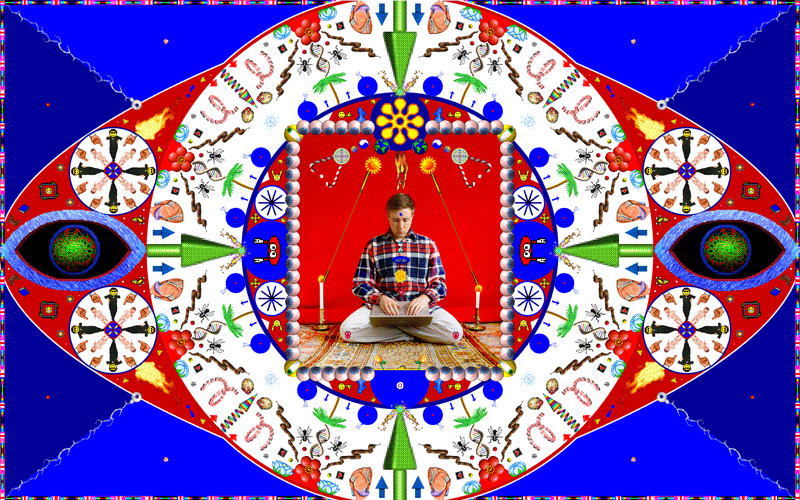



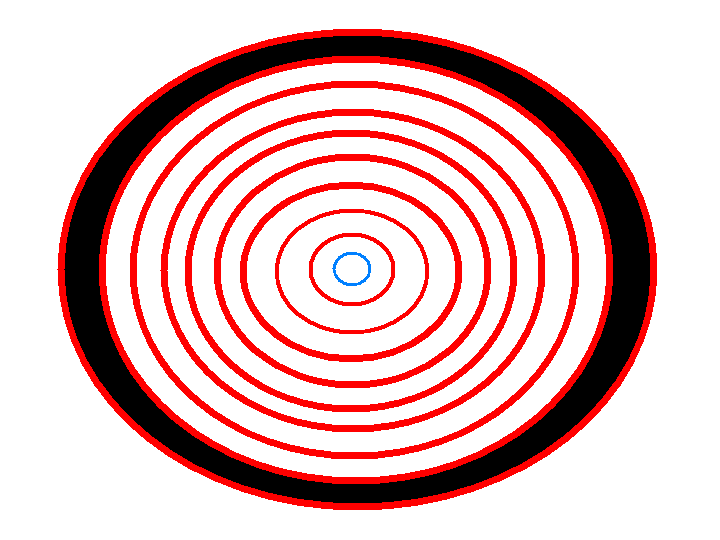

Nema komentara:
Objavi komentar